:max_bytes(150000):strip_icc():format(webp)/how-to-choose-your-ideal-phonecase-ca91460721b143b0b0ae61b5baf11b3c.jpg)
Elevate Your Storytelling Adding Picture-in-Picture Elements to Your FCP Projects for 2024

Elevate Your Storytelling: Adding Picture-in-Picture Elements to Your FCP Projects
How to Create a Picture-in-Picture Effect Using Final Cut Pro

Benjamin Arango
Mar 27, 2024• Proven solutions
Sometimes we need to show two videos together on the same screen to convey certain usage information. If you are searching for a tool to make this task possible then Final Cut Pro is the best choice for you.
This tool can help you to use the picture-in-picture effect with ease. However, the process for adding this effect cannot be completed within one r two steps.
The article below contains complete details about how to add PIP effects using Final Cut Pro. You will be glad to know that FCP also works with few integrated plugins that assist in the free picture in picture effect generation.
How to Create PIP Effect with FCP
If you are ready with two videos and now want to bring them to the same screen then prefer to follow these simple steps:
Step 1: Add Background video
The very first step that you need to follow for PIP effect generation using FCP is to bring your main or background video to the timeline as a primary storyline. Once you have created the primary storyline then all videos for the PIP effect will be added to it.

Step 2: Add PIP videos
It is time to choose the higher video clip so that the PIP effect can be applied. This task can be done either by using on-screen type controls available on the viewer or you can move ahead with transform controls available on the inspector.
Note that lower clips use to stay in the background in final results whereas upper clips will appear in the foreground. By default, both clips use to have 100% full screen with 100% opaque settings.
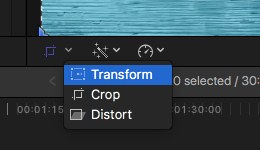
Step 3: Apply PIP effect
As now you have added both videos on-screen now you have to select the higher video and then click over the rectangular transform button that is available on the lower-left corner of viewer screen. As soon as you make this selection, the icon will turn into blue color, and naturally 8 dots will appear around the selected image or video. Use any one of these dots for scaling your selection in asymmetrical order.

Step 4: Adjust PIP Effect
- If you want to scale this image in a symmetrical fashion then simply drag the dot to the corner from the central position.
- Now hold the option key and drag one dot to the corner. It will help you to shrink as well as to enlarge the image even without affecting its actual aspect ratio.
- Users can keep on scaling this foreground image till the time they achieve essential size.
- Now click inside your selected image and start dragging it to reach a certain specific position. You can place it anywhere on a big screen.
Step 5: Follow precise Adjustment
Simply select the top clip and then hit Command + 4 to open the inspector. Now click on that blue show button over your FCP screen and it will provide you complete information about the transform category of available built-in effects. If you use inspector for this task then it can help you to get very precise results for scaling needs. It assists users to manage images with accurate position and size.

Step 6: Apply Cross- Dissolve
- Now choose the leading edge of effect and use Command + T. It will immediately apply the default cross-dissolve option for starting clip.
- You will be glad to know that the PIP effect does not restrict users to work just upon a single image rather it can be used to process as many pictures as your project needs and that can fit inside the frame.

Check this video tutorial to know more details:
Picture in Picture Plug-ins for Final Cut Pro
There are so many plug-ins available in the market for Final Cut Pro platform and all of them possess unique qualities along with impressive toolsets. No matter whether you are a beginner with the PIP effect or professional making high-end video projects, FCP plug-ins can make your task much easier with their intuitive controls.
1. Tokyo PiPintor
PiPintor Free is a specially designed picture-in-picture plugin that assists beginners with easy processing of the PIP effect over Final Cut Pro platform. It simply awakes the menu-driven animation power on your tool so that picture in picture effect can be completed without key-framing.
2. ProPIP
Those who need to enjoy a higher level of customizations are advised to work over ProPIP environment. This advanced tool assists users to showcase their abilities with full freedom for personalization.
ProPIP is the best choice for newscasting, commentaries, and many other applications. It helps in generating fine controls for initial as well as end position, rotation, and scaling effects along with easy-to-use media controls over the screen. ProPIP also provides personalized borders with endless opportunities to develop impressive projects on Final Cut Pro platform.

Benjamin Arango
Benjamin Arango is a writer and a lover of all things video.
Follow @Benjamin Arango
Benjamin Arango
Mar 27, 2024• Proven solutions
Sometimes we need to show two videos together on the same screen to convey certain usage information. If you are searching for a tool to make this task possible then Final Cut Pro is the best choice for you.
This tool can help you to use the picture-in-picture effect with ease. However, the process for adding this effect cannot be completed within one r two steps.
The article below contains complete details about how to add PIP effects using Final Cut Pro. You will be glad to know that FCP also works with few integrated plugins that assist in the free picture in picture effect generation.
How to Create PIP Effect with FCP
If you are ready with two videos and now want to bring them to the same screen then prefer to follow these simple steps:
Step 1: Add Background video
The very first step that you need to follow for PIP effect generation using FCP is to bring your main or background video to the timeline as a primary storyline. Once you have created the primary storyline then all videos for the PIP effect will be added to it.

Step 2: Add PIP videos
It is time to choose the higher video clip so that the PIP effect can be applied. This task can be done either by using on-screen type controls available on the viewer or you can move ahead with transform controls available on the inspector.
Note that lower clips use to stay in the background in final results whereas upper clips will appear in the foreground. By default, both clips use to have 100% full screen with 100% opaque settings.

Step 3: Apply PIP effect
As now you have added both videos on-screen now you have to select the higher video and then click over the rectangular transform button that is available on the lower-left corner of viewer screen. As soon as you make this selection, the icon will turn into blue color, and naturally 8 dots will appear around the selected image or video. Use any one of these dots for scaling your selection in asymmetrical order.

Step 4: Adjust PIP Effect
- If you want to scale this image in a symmetrical fashion then simply drag the dot to the corner from the central position.
- Now hold the option key and drag one dot to the corner. It will help you to shrink as well as to enlarge the image even without affecting its actual aspect ratio.
- Users can keep on scaling this foreground image till the time they achieve essential size.
- Now click inside your selected image and start dragging it to reach a certain specific position. You can place it anywhere on a big screen.
Step 5: Follow precise Adjustment
Simply select the top clip and then hit Command + 4 to open the inspector. Now click on that blue show button over your FCP screen and it will provide you complete information about the transform category of available built-in effects. If you use inspector for this task then it can help you to get very precise results for scaling needs. It assists users to manage images with accurate position and size.

Step 6: Apply Cross- Dissolve
- Now choose the leading edge of effect and use Command + T. It will immediately apply the default cross-dissolve option for starting clip.
- You will be glad to know that the PIP effect does not restrict users to work just upon a single image rather it can be used to process as many pictures as your project needs and that can fit inside the frame.

Check this video tutorial to know more details:
Picture in Picture Plug-ins for Final Cut Pro
There are so many plug-ins available in the market for Final Cut Pro platform and all of them possess unique qualities along with impressive toolsets. No matter whether you are a beginner with the PIP effect or professional making high-end video projects, FCP plug-ins can make your task much easier with their intuitive controls.
1. Tokyo PiPintor
PiPintor Free is a specially designed picture-in-picture plugin that assists beginners with easy processing of the PIP effect over Final Cut Pro platform. It simply awakes the menu-driven animation power on your tool so that picture in picture effect can be completed without key-framing.
2. ProPIP
Those who need to enjoy a higher level of customizations are advised to work over ProPIP environment. This advanced tool assists users to showcase their abilities with full freedom for personalization.
ProPIP is the best choice for newscasting, commentaries, and many other applications. It helps in generating fine controls for initial as well as end position, rotation, and scaling effects along with easy-to-use media controls over the screen. ProPIP also provides personalized borders with endless opportunities to develop impressive projects on Final Cut Pro platform.

Benjamin Arango
Benjamin Arango is a writer and a lover of all things video.
Follow @Benjamin Arango
Benjamin Arango
Mar 27, 2024• Proven solutions
Sometimes we need to show two videos together on the same screen to convey certain usage information. If you are searching for a tool to make this task possible then Final Cut Pro is the best choice for you.
This tool can help you to use the picture-in-picture effect with ease. However, the process for adding this effect cannot be completed within one r two steps.
The article below contains complete details about how to add PIP effects using Final Cut Pro. You will be glad to know that FCP also works with few integrated plugins that assist in the free picture in picture effect generation.
How to Create PIP Effect with FCP
If you are ready with two videos and now want to bring them to the same screen then prefer to follow these simple steps:
Step 1: Add Background video
The very first step that you need to follow for PIP effect generation using FCP is to bring your main or background video to the timeline as a primary storyline. Once you have created the primary storyline then all videos for the PIP effect will be added to it.

Step 2: Add PIP videos
It is time to choose the higher video clip so that the PIP effect can be applied. This task can be done either by using on-screen type controls available on the viewer or you can move ahead with transform controls available on the inspector.
Note that lower clips use to stay in the background in final results whereas upper clips will appear in the foreground. By default, both clips use to have 100% full screen with 100% opaque settings.

Step 3: Apply PIP effect
As now you have added both videos on-screen now you have to select the higher video and then click over the rectangular transform button that is available on the lower-left corner of viewer screen. As soon as you make this selection, the icon will turn into blue color, and naturally 8 dots will appear around the selected image or video. Use any one of these dots for scaling your selection in asymmetrical order.

Step 4: Adjust PIP Effect
- If you want to scale this image in a symmetrical fashion then simply drag the dot to the corner from the central position.
- Now hold the option key and drag one dot to the corner. It will help you to shrink as well as to enlarge the image even without affecting its actual aspect ratio.
- Users can keep on scaling this foreground image till the time they achieve essential size.
- Now click inside your selected image and start dragging it to reach a certain specific position. You can place it anywhere on a big screen.
Step 5: Follow precise Adjustment
Simply select the top clip and then hit Command + 4 to open the inspector. Now click on that blue show button over your FCP screen and it will provide you complete information about the transform category of available built-in effects. If you use inspector for this task then it can help you to get very precise results for scaling needs. It assists users to manage images with accurate position and size.

Step 6: Apply Cross- Dissolve
- Now choose the leading edge of effect and use Command + T. It will immediately apply the default cross-dissolve option for starting clip.
- You will be glad to know that the PIP effect does not restrict users to work just upon a single image rather it can be used to process as many pictures as your project needs and that can fit inside the frame.

Check this video tutorial to know more details:
Picture in Picture Plug-ins for Final Cut Pro
There are so many plug-ins available in the market for Final Cut Pro platform and all of them possess unique qualities along with impressive toolsets. No matter whether you are a beginner with the PIP effect or professional making high-end video projects, FCP plug-ins can make your task much easier with their intuitive controls.
1. Tokyo PiPintor
PiPintor Free is a specially designed picture-in-picture plugin that assists beginners with easy processing of the PIP effect over Final Cut Pro platform. It simply awakes the menu-driven animation power on your tool so that picture in picture effect can be completed without key-framing.
2. ProPIP
Those who need to enjoy a higher level of customizations are advised to work over ProPIP environment. This advanced tool assists users to showcase their abilities with full freedom for personalization.
ProPIP is the best choice for newscasting, commentaries, and many other applications. It helps in generating fine controls for initial as well as end position, rotation, and scaling effects along with easy-to-use media controls over the screen. ProPIP also provides personalized borders with endless opportunities to develop impressive projects on Final Cut Pro platform.

Benjamin Arango
Benjamin Arango is a writer and a lover of all things video.
Follow @Benjamin Arango
Benjamin Arango
Mar 27, 2024• Proven solutions
Sometimes we need to show two videos together on the same screen to convey certain usage information. If you are searching for a tool to make this task possible then Final Cut Pro is the best choice for you.
This tool can help you to use the picture-in-picture effect with ease. However, the process for adding this effect cannot be completed within one r two steps.
The article below contains complete details about how to add PIP effects using Final Cut Pro. You will be glad to know that FCP also works with few integrated plugins that assist in the free picture in picture effect generation.
How to Create PIP Effect with FCP
If you are ready with two videos and now want to bring them to the same screen then prefer to follow these simple steps:
Step 1: Add Background video
The very first step that you need to follow for PIP effect generation using FCP is to bring your main or background video to the timeline as a primary storyline. Once you have created the primary storyline then all videos for the PIP effect will be added to it.

Step 2: Add PIP videos
It is time to choose the higher video clip so that the PIP effect can be applied. This task can be done either by using on-screen type controls available on the viewer or you can move ahead with transform controls available on the inspector.
Note that lower clips use to stay in the background in final results whereas upper clips will appear in the foreground. By default, both clips use to have 100% full screen with 100% opaque settings.

Step 3: Apply PIP effect
As now you have added both videos on-screen now you have to select the higher video and then click over the rectangular transform button that is available on the lower-left corner of viewer screen. As soon as you make this selection, the icon will turn into blue color, and naturally 8 dots will appear around the selected image or video. Use any one of these dots for scaling your selection in asymmetrical order.

Step 4: Adjust PIP Effect
- If you want to scale this image in a symmetrical fashion then simply drag the dot to the corner from the central position.
- Now hold the option key and drag one dot to the corner. It will help you to shrink as well as to enlarge the image even without affecting its actual aspect ratio.
- Users can keep on scaling this foreground image till the time they achieve essential size.
- Now click inside your selected image and start dragging it to reach a certain specific position. You can place it anywhere on a big screen.
Step 5: Follow precise Adjustment
Simply select the top clip and then hit Command + 4 to open the inspector. Now click on that blue show button over your FCP screen and it will provide you complete information about the transform category of available built-in effects. If you use inspector for this task then it can help you to get very precise results for scaling needs. It assists users to manage images with accurate position and size.

Step 6: Apply Cross- Dissolve
- Now choose the leading edge of effect and use Command + T. It will immediately apply the default cross-dissolve option for starting clip.
- You will be glad to know that the PIP effect does not restrict users to work just upon a single image rather it can be used to process as many pictures as your project needs and that can fit inside the frame.

Check this video tutorial to know more details:
Picture in Picture Plug-ins for Final Cut Pro
There are so many plug-ins available in the market for Final Cut Pro platform and all of them possess unique qualities along with impressive toolsets. No matter whether you are a beginner with the PIP effect or professional making high-end video projects, FCP plug-ins can make your task much easier with their intuitive controls.
1. Tokyo PiPintor
PiPintor Free is a specially designed picture-in-picture plugin that assists beginners with easy processing of the PIP effect over Final Cut Pro platform. It simply awakes the menu-driven animation power on your tool so that picture in picture effect can be completed without key-framing.
2. ProPIP
Those who need to enjoy a higher level of customizations are advised to work over ProPIP environment. This advanced tool assists users to showcase their abilities with full freedom for personalization.
ProPIP is the best choice for newscasting, commentaries, and many other applications. It helps in generating fine controls for initial as well as end position, rotation, and scaling effects along with easy-to-use media controls over the screen. ProPIP also provides personalized borders with endless opportunities to develop impressive projects on Final Cut Pro platform.

Benjamin Arango
Benjamin Arango is a writer and a lover of all things video.
Follow @Benjamin Arango
How to Make a Time Lapse Video in Final Cut Pro
How to Make a Time Lapse Video in Final Cut Pro

Benjamin Arango
Mar 27, 2024• Proven solutions
It will be more interesting to change the speed of a video to give your project a totally different feeling, for example, by speeding up a video of a city’s traffic or the flow of clouds. Final Cut Pro offers users multiple options to adjust video speed easily, including time-lapse.
In this article, we are going to show you how you can easily increase the speed of your video from 2X up to 20X with Final Cut Pro. Also, you can choose manual custom speed as you like.
You May Also Like: How to Make Freeze-Frames and Slow Motion >>
This is a basic tutorial about Apple Final Cut Pro X, a professional video editing software. However, if video editing is new to you, consider Wondershare Filmora for Mac (Originally Wondershare Video Editor for Mac). This is a powerful but easy-to-use tool for users just starting out. Download the free trial version below to try it right now. And here’s a video tutorial on how to make a time-lapse video with Filmora for your reference:
 Download Mac Version ](https://tools.techidaily.com/wondershare/filmora/download/ )
Download Mac Version ](https://tools.techidaily.com/wondershare/filmora/download/ )
How to Make a Time-Lapse Video in Final Cut Pro
Step 1 Import Clips
Choose File > New > Event. Name it and click OK. Label the project Timelapse. Then go to File > Import Media. Browse to source clips folder. Click Import Selected. Drop the clips onto the timeline.
Step 2 Apply Time-lapse Effect
Click the Retime pop-up menu below the viewer and choose Fast (or you can access Modify > Retime > Fast). There are 4 preset options you can choose: 2x, 4x, 8x, 20x. Or you can customize the speed by selecting Custom.
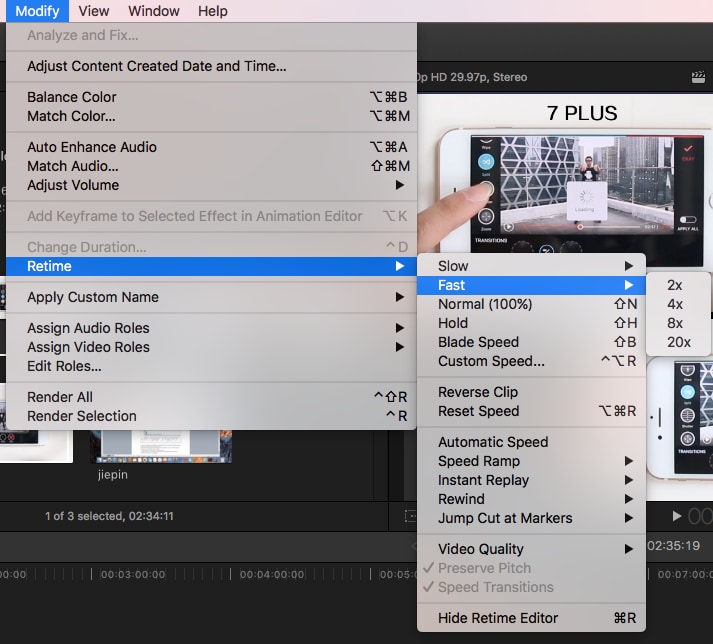
You can set any speed by adjusting the Rate. Reset the speed by clicking on the little arrow on the right side of the window.
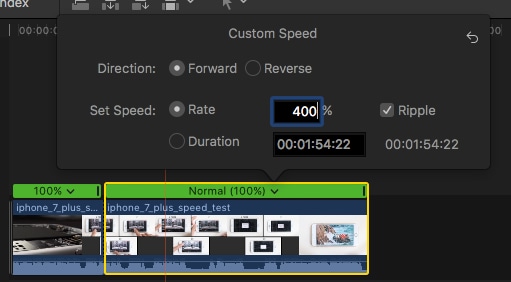
You can also drag the retiming handle to adjust the speed: dragging to the left increases the speed, and dragging to the right decreases it.
Note: To set speed separately for different parts of one clip, you can choose Blade Speed first, and then blade the clip where you want to set different speeds.
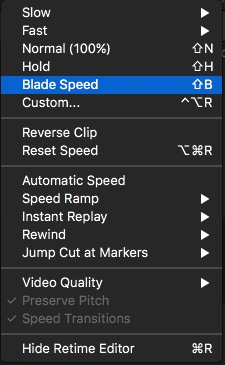
That’s it. You may also want to learn this: how to add a countdown-timer in fcpx
If you have any questions about making time-lapse videos, feel free to drop a line below.

Benjamin Arango
Benjamin Arango is a writer and a lover of all things video.
Follow @Benjamin Arango
Benjamin Arango
Mar 27, 2024• Proven solutions
It will be more interesting to change the speed of a video to give your project a totally different feeling, for example, by speeding up a video of a city’s traffic or the flow of clouds. Final Cut Pro offers users multiple options to adjust video speed easily, including time-lapse.
In this article, we are going to show you how you can easily increase the speed of your video from 2X up to 20X with Final Cut Pro. Also, you can choose manual custom speed as you like.
You May Also Like: How to Make Freeze-Frames and Slow Motion >>
This is a basic tutorial about Apple Final Cut Pro X, a professional video editing software. However, if video editing is new to you, consider Wondershare Filmora for Mac (Originally Wondershare Video Editor for Mac). This is a powerful but easy-to-use tool for users just starting out. Download the free trial version below to try it right now. And here’s a video tutorial on how to make a time-lapse video with Filmora for your reference:
 Download Mac Version ](https://tools.techidaily.com/wondershare/filmora/download/ )
Download Mac Version ](https://tools.techidaily.com/wondershare/filmora/download/ )
How to Make a Time-Lapse Video in Final Cut Pro
Step 1 Import Clips
Choose File > New > Event. Name it and click OK. Label the project Timelapse. Then go to File > Import Media. Browse to source clips folder. Click Import Selected. Drop the clips onto the timeline.
Step 2 Apply Time-lapse Effect
Click the Retime pop-up menu below the viewer and choose Fast (or you can access Modify > Retime > Fast). There are 4 preset options you can choose: 2x, 4x, 8x, 20x. Or you can customize the speed by selecting Custom.

You can set any speed by adjusting the Rate. Reset the speed by clicking on the little arrow on the right side of the window.

You can also drag the retiming handle to adjust the speed: dragging to the left increases the speed, and dragging to the right decreases it.
Note: To set speed separately for different parts of one clip, you can choose Blade Speed first, and then blade the clip where you want to set different speeds.

That’s it. You may also want to learn this: how to add a countdown-timer in fcpx
If you have any questions about making time-lapse videos, feel free to drop a line below.

Benjamin Arango
Benjamin Arango is a writer and a lover of all things video.
Follow @Benjamin Arango
Benjamin Arango
Mar 27, 2024• Proven solutions
It will be more interesting to change the speed of a video to give your project a totally different feeling, for example, by speeding up a video of a city’s traffic or the flow of clouds. Final Cut Pro offers users multiple options to adjust video speed easily, including time-lapse.
In this article, we are going to show you how you can easily increase the speed of your video from 2X up to 20X with Final Cut Pro. Also, you can choose manual custom speed as you like.
You May Also Like: How to Make Freeze-Frames and Slow Motion >>
This is a basic tutorial about Apple Final Cut Pro X, a professional video editing software. However, if video editing is new to you, consider Wondershare Filmora for Mac (Originally Wondershare Video Editor for Mac). This is a powerful but easy-to-use tool for users just starting out. Download the free trial version below to try it right now. And here’s a video tutorial on how to make a time-lapse video with Filmora for your reference:
 Download Mac Version ](https://tools.techidaily.com/wondershare/filmora/download/ )
Download Mac Version ](https://tools.techidaily.com/wondershare/filmora/download/ )
How to Make a Time-Lapse Video in Final Cut Pro
Step 1 Import Clips
Choose File > New > Event. Name it and click OK. Label the project Timelapse. Then go to File > Import Media. Browse to source clips folder. Click Import Selected. Drop the clips onto the timeline.
Step 2 Apply Time-lapse Effect
Click the Retime pop-up menu below the viewer and choose Fast (or you can access Modify > Retime > Fast). There are 4 preset options you can choose: 2x, 4x, 8x, 20x. Or you can customize the speed by selecting Custom.

You can set any speed by adjusting the Rate. Reset the speed by clicking on the little arrow on the right side of the window.

You can also drag the retiming handle to adjust the speed: dragging to the left increases the speed, and dragging to the right decreases it.
Note: To set speed separately for different parts of one clip, you can choose Blade Speed first, and then blade the clip where you want to set different speeds.

That’s it. You may also want to learn this: how to add a countdown-timer in fcpx
If you have any questions about making time-lapse videos, feel free to drop a line below.

Benjamin Arango
Benjamin Arango is a writer and a lover of all things video.
Follow @Benjamin Arango
Benjamin Arango
Mar 27, 2024• Proven solutions
It will be more interesting to change the speed of a video to give your project a totally different feeling, for example, by speeding up a video of a city’s traffic or the flow of clouds. Final Cut Pro offers users multiple options to adjust video speed easily, including time-lapse.
In this article, we are going to show you how you can easily increase the speed of your video from 2X up to 20X with Final Cut Pro. Also, you can choose manual custom speed as you like.
You May Also Like: How to Make Freeze-Frames and Slow Motion >>
This is a basic tutorial about Apple Final Cut Pro X, a professional video editing software. However, if video editing is new to you, consider Wondershare Filmora for Mac (Originally Wondershare Video Editor for Mac). This is a powerful but easy-to-use tool for users just starting out. Download the free trial version below to try it right now. And here’s a video tutorial on how to make a time-lapse video with Filmora for your reference:
 Download Mac Version ](https://tools.techidaily.com/wondershare/filmora/download/ )
Download Mac Version ](https://tools.techidaily.com/wondershare/filmora/download/ )
How to Make a Time-Lapse Video in Final Cut Pro
Step 1 Import Clips
Choose File > New > Event. Name it and click OK. Label the project Timelapse. Then go to File > Import Media. Browse to source clips folder. Click Import Selected. Drop the clips onto the timeline.
Step 2 Apply Time-lapse Effect
Click the Retime pop-up menu below the viewer and choose Fast (or you can access Modify > Retime > Fast). There are 4 preset options you can choose: 2x, 4x, 8x, 20x. Or you can customize the speed by selecting Custom.

You can set any speed by adjusting the Rate. Reset the speed by clicking on the little arrow on the right side of the window.

You can also drag the retiming handle to adjust the speed: dragging to the left increases the speed, and dragging to the right decreases it.
Note: To set speed separately for different parts of one clip, you can choose Blade Speed first, and then blade the clip where you want to set different speeds.

That’s it. You may also want to learn this: how to add a countdown-timer in fcpx
If you have any questions about making time-lapse videos, feel free to drop a line below.

Benjamin Arango
Benjamin Arango is a writer and a lover of all things video.
Follow @Benjamin Arango
Best Luminance Adjusters for Video
Do you face these kinds of issues a lot while you’re shooting through your phone? Although you may make a video at any time using your iPhone or Android smartphone, you are much more likely to face a dull environment that you cannot adjust at the time. Filming in low light may result in a video that is too dark to see clearly and may potentially degrade video quality.
In such cases, employing a video brightness program on your smartphone or Windows computer might be one of the finest ways to brighten a video. Hence, we’ve compiled a list of some excellent Video Brightness Editor tools for you on this page. Read ahead to learn more about their brightness settings and other options.
In this article
01 Best Online Video Editors to Adjust Video Brightness
02 Best Desktop Video Editors to Adjust Video Brightness
Part 1: Best Online Video Editors to Adjust Video Brightness
There are software and internet resources that can assist you in resolving this issue. You may brighten your movies without exerting any effort if you use the correct video brightener application or website. Read about some of this software when you want to learn more about brightening videos.
1. Veed.io
Is it too dark to watch your visuals? There is “light” at the end of the tunnel, so don’t panic. You may alter the brightness, contrast, color distribution, backdrop, transparency, and more in your movie using Veed.io color, vibrancy, and flare may be added to your videos.
Alternatively, for a dramatic impact, lower it a little! Our expert brightness editor will bring out the finest in your video, no matter what it is. Launch your preferred web browser, such as Chrome, Opera, or Mozilla Firefox.
To brighten your videos, upload your video to VEED’s video editor. Select ‘Adjust’ after clicking the video track. From left to right, move the Brightness key. You can make gorgeous videos for every social media site, especially intro videos, using VEED (with their Intro Maker). To stay on brand, include your emblem and your graphics.
2. Kapwing
Another video brightener is Kapwing Video Editor, which brightens videos online without requiring any installations. There is a choice to enter a video URL to add light to the video when utilizing the following online effects to illuminate the video-sharing site.
You may also edit and brighten video by uploading it from your computer’s hard disk. There are various more video-related tools available on the internet that assist you in beautifying films for social media posting.
Most of the functionality found in the other social network video editors on our list are available, including video templates, ways to resize and cut your video clips, text tools, and even some basic geometric shapes.
You may also convert, trim, resize, and loop videos with at least 15 video tools, many of which are incorporated with the main Studio software. You may perform everything for free and without any hassle. The subtitle tool, for example, is a fantastic tool that allows users to upload subtitles to the industry standard.SRT file.
3. Clipchamp
The first semi-professional video editor on this roster is Clipchamp. Clipchamp includes video templates for just about any scenario you can think of. The program also provides videos in a range of aspect ratios. There’s also a good selection of stock audio and video.
You’ll also receive a video converter, a video compressor, and a webcam recorder, as well as a few more tools for basic video handling. Essentially, the platform includes everything you’ll need to create simple films without having to spend lots of money on technology.
Place your video on the timeline by dragging and dropping it. The editing menu will show when you click on the video. Click “Color Exposure” in the editing menu, and a window with four slider settings will display. To brighten the video, use the “Exposure” slider to the right.
4. Clideo
Clideo is a cute website that can be used to brighten up dreary films. This website allows you to modify video brightness for free, and you may use it without installing something on your computer. The site is free, but there are certain limits, so you’ll need to upgrade to the premium version to use all of the features. Because it is online and operates straight in the browser, you may use it to adjust the brightness of your Windows 7 computer.
All you have to do now is upload the video from your computer that you wish to modify. You may upload up to 500 MBs in the free version. You’ll find modification settings on the right when your movie has been uploaded. To lighten your video, drag the Brightness slider to the right. After you’ve made the necessary edits, you may save the movie to your computer.
Part 2: Best Desktop Video Editors to Adjust Video Brightness
It’s difficult to constantly record a video in great light, so you attempt to brighten a dark movie or modify the brightness of a video to make it appear better for sharing. For the majority of individuals, adjusting the video brightness is a time-consuming and even unpleasant experience in their everyday lives for a variety of reasons.
As a result, many people want to know which desktop video editors are the best for adjusting video brightness. Learn about the applications that can assist you in this endeavor by reading on.
1. Wondershare Filmora Video Editor
Wondershare Filmora is an excellent choice when you need to get started with simple video editing features while also having the possibility to progress. If you’re concerned about dark videos, Filmora can comfortably solve the issue. Click on the Import option and choose the file of your liking. Then apply changes from the adjustment settings to make it look worthwhile!
For Win 7 or later (64-bit)
For macOS 10.12 or later
Filmora video editor allows you to adjust the brightness with the auto enhance feature in one-click. What’s more, it provides the color match feature which allows you to match the color between different clips.
2. VSDC Free Video Editor
The VSDC Free Footage Editor, in the hands of a skilled user, can generate some truly professional-looking videos. The application supports virtually all major video formats and includes complex video effects such as object transformation and color correction, and also advanced audio effects such as volume adjustment and sound normalization. You have the luxury of brightening your videos simply by uploading the video from your desktop and making whatever changes that you want to make.
VSDC Free Video Editor is actually free, unlike certain “high-end” editors. You may utilize the whole feature set of the application without having to contend with annoying watermarks. Unfortunately, there is one snag. You must pay if you want technical assistance. (And there’s a strong possibility you’ll have to.) Subscription for the VSDC Free Video Editor is $1 per month, $5 per half-year, and $10 per year.
3. iMovie
iMovie for Mac allows you to experience your films in new ways. Make Hollywood-style teasers and gorgeous movies in excellent 4K resolution by quickly browsing your footage and instantly sharing your best moments. Color Balance and Color Correction are two options for brightening a movie in iMovie 10.1 or later. The former has four tabs: Auto, Match Color, White Balance, and Skin Tone Balance, which allow you to make automated color adjustments.
The latter has sliders for manually adjusting brightness, contrast, saturation, shadows, and other parameters. Simply choose the clip you want to change and then select the appropriate tool from the toolbar above the viewer. It’s not very technical, but it makes it simple to brighten up a gloomy video.
4. Premiere Pro CC
Premiere Pro includes a user interface that is both appealing and versatile. The startup feature enables you to rapidly return to previous projects, start new ones, or browse for Adobe Stock video. You can switch between workspaces for Assembly, Editing, Color, Effects, Audio, and Titles, and the dark system window tends to make your videos the focus of attention.
Premiere Pro CC is another desktop video editor that you can use to brighten your videos. The various parameters in the Lumetri Color panel window inside Premiere Pro CC may be used to accomplish video color correction.
Premiere Pro’s Lumetri Color Tools elevate the application to the level of Photoshop for video. These tools provide a surprising amount of color modification and a wide range of film and HDR effects. With keyframes, you may modify the white balance, exposure, contrast, highlights, shadows, and black point, among other things. Modifications for Saturation, Vibrance, Faded Film and Sharpen are also accessible.
5. Final Cut Pro
Final Cut Pro comes with a set of robust manual color correction features that can be used to achieve a wide range of color correction and enhancement features. Creating a color correction effect and then modifying the effect’s settings in the Color inspector is how you utilize the tools. Any of the following color correction effects may be used to make manual color modifications to the color tint, brightness, and contrast of the entire clip picture.
Color correction capabilities in Final Cut Pro allow you to fine-tune the look of any video in your project, including still photos, by adjusting color balance, shadow levels, mid-tone thresholds, highlight levels, and much more. Saturation, exposure, and color modifications are all controlled via the Color Board. Adjust the Brightness in the color adjustment panels to brighten your movies.
Conclusion
Adjusting brightness has become a “small problem” for many. Oftentimes, you record a video, and it falls short of the brightness criteria – it’s too dark! However, when you have quality Video Brightness Editors, like the ones we have reviewed above, you’re in good hands. Not only are these apps easy to use with excellent functionality, but they also make editing a piece of cake for everyone.
02 Best Desktop Video Editors to Adjust Video Brightness
Part 1: Best Online Video Editors to Adjust Video Brightness
There are software and internet resources that can assist you in resolving this issue. You may brighten your movies without exerting any effort if you use the correct video brightener application or website. Read about some of this software when you want to learn more about brightening videos.
1. Veed.io
Is it too dark to watch your visuals? There is “light” at the end of the tunnel, so don’t panic. You may alter the brightness, contrast, color distribution, backdrop, transparency, and more in your movie using Veed.io color, vibrancy, and flare may be added to your videos.
Alternatively, for a dramatic impact, lower it a little! Our expert brightness editor will bring out the finest in your video, no matter what it is. Launch your preferred web browser, such as Chrome, Opera, or Mozilla Firefox.
To brighten your videos, upload your video to VEED’s video editor. Select ‘Adjust’ after clicking the video track. From left to right, move the Brightness key. You can make gorgeous videos for every social media site, especially intro videos, using VEED (with their Intro Maker). To stay on brand, include your emblem and your graphics.
2. Kapwing
Another video brightener is Kapwing Video Editor, which brightens videos online without requiring any installations. There is a choice to enter a video URL to add light to the video when utilizing the following online effects to illuminate the video-sharing site.
You may also edit and brighten video by uploading it from your computer’s hard disk. There are various more video-related tools available on the internet that assist you in beautifying films for social media posting.
Most of the functionality found in the other social network video editors on our list are available, including video templates, ways to resize and cut your video clips, text tools, and even some basic geometric shapes.
You may also convert, trim, resize, and loop videos with at least 15 video tools, many of which are incorporated with the main Studio software. You may perform everything for free and without any hassle. The subtitle tool, for example, is a fantastic tool that allows users to upload subtitles to the industry standard.SRT file.
3. Clipchamp
The first semi-professional video editor on this roster is Clipchamp. Clipchamp includes video templates for just about any scenario you can think of. The program also provides videos in a range of aspect ratios. There’s also a good selection of stock audio and video.
You’ll also receive a video converter, a video compressor, and a webcam recorder, as well as a few more tools for basic video handling. Essentially, the platform includes everything you’ll need to create simple films without having to spend lots of money on technology.
Place your video on the timeline by dragging and dropping it. The editing menu will show when you click on the video. Click “Color Exposure” in the editing menu, and a window with four slider settings will display. To brighten the video, use the “Exposure” slider to the right.
4. Clideo
Clideo is a cute website that can be used to brighten up dreary films. This website allows you to modify video brightness for free, and you may use it without installing something on your computer. The site is free, but there are certain limits, so you’ll need to upgrade to the premium version to use all of the features. Because it is online and operates straight in the browser, you may use it to adjust the brightness of your Windows 7 computer.
All you have to do now is upload the video from your computer that you wish to modify. You may upload up to 500 MBs in the free version. You’ll find modification settings on the right when your movie has been uploaded. To lighten your video, drag the Brightness slider to the right. After you’ve made the necessary edits, you may save the movie to your computer.
Part 2: Best Desktop Video Editors to Adjust Video Brightness
It’s difficult to constantly record a video in great light, so you attempt to brighten a dark movie or modify the brightness of a video to make it appear better for sharing. For the majority of individuals, adjusting the video brightness is a time-consuming and even unpleasant experience in their everyday lives for a variety of reasons.
As a result, many people want to know which desktop video editors are the best for adjusting video brightness. Learn about the applications that can assist you in this endeavor by reading on.
1. Wondershare Filmora Video Editor
Wondershare Filmora is an excellent choice when you need to get started with simple video editing features while also having the possibility to progress. If you’re concerned about dark videos, Filmora can comfortably solve the issue. Click on the Import option and choose the file of your liking. Then apply changes from the adjustment settings to make it look worthwhile!
For Win 7 or later (64-bit)
For macOS 10.12 or later
Filmora video editor allows you to adjust the brightness with the auto enhance feature in one-click. What’s more, it provides the color match feature which allows you to match the color between different clips.
2. VSDC Free Video Editor
The VSDC Free Footage Editor, in the hands of a skilled user, can generate some truly professional-looking videos. The application supports virtually all major video formats and includes complex video effects such as object transformation and color correction, and also advanced audio effects such as volume adjustment and sound normalization. You have the luxury of brightening your videos simply by uploading the video from your desktop and making whatever changes that you want to make.
VSDC Free Video Editor is actually free, unlike certain “high-end” editors. You may utilize the whole feature set of the application without having to contend with annoying watermarks. Unfortunately, there is one snag. You must pay if you want technical assistance. (And there’s a strong possibility you’ll have to.) Subscription for the VSDC Free Video Editor is $1 per month, $5 per half-year, and $10 per year.
3. iMovie
iMovie for Mac allows you to experience your films in new ways. Make Hollywood-style teasers and gorgeous movies in excellent 4K resolution by quickly browsing your footage and instantly sharing your best moments. Color Balance and Color Correction are two options for brightening a movie in iMovie 10.1 or later. The former has four tabs: Auto, Match Color, White Balance, and Skin Tone Balance, which allow you to make automated color adjustments.
The latter has sliders for manually adjusting brightness, contrast, saturation, shadows, and other parameters. Simply choose the clip you want to change and then select the appropriate tool from the toolbar above the viewer. It’s not very technical, but it makes it simple to brighten up a gloomy video.
4. Premiere Pro CC
Premiere Pro includes a user interface that is both appealing and versatile. The startup feature enables you to rapidly return to previous projects, start new ones, or browse for Adobe Stock video. You can switch between workspaces for Assembly, Editing, Color, Effects, Audio, and Titles, and the dark system window tends to make your videos the focus of attention.
Premiere Pro CC is another desktop video editor that you can use to brighten your videos. The various parameters in the Lumetri Color panel window inside Premiere Pro CC may be used to accomplish video color correction.
Premiere Pro’s Lumetri Color Tools elevate the application to the level of Photoshop for video. These tools provide a surprising amount of color modification and a wide range of film and HDR effects. With keyframes, you may modify the white balance, exposure, contrast, highlights, shadows, and black point, among other things. Modifications for Saturation, Vibrance, Faded Film and Sharpen are also accessible.
5. Final Cut Pro
Final Cut Pro comes with a set of robust manual color correction features that can be used to achieve a wide range of color correction and enhancement features. Creating a color correction effect and then modifying the effect’s settings in the Color inspector is how you utilize the tools. Any of the following color correction effects may be used to make manual color modifications to the color tint, brightness, and contrast of the entire clip picture.
Color correction capabilities in Final Cut Pro allow you to fine-tune the look of any video in your project, including still photos, by adjusting color balance, shadow levels, mid-tone thresholds, highlight levels, and much more. Saturation, exposure, and color modifications are all controlled via the Color Board. Adjust the Brightness in the color adjustment panels to brighten your movies.
Conclusion
Adjusting brightness has become a “small problem” for many. Oftentimes, you record a video, and it falls short of the brightness criteria – it’s too dark! However, when you have quality Video Brightness Editors, like the ones we have reviewed above, you’re in good hands. Not only are these apps easy to use with excellent functionality, but they also make editing a piece of cake for everyone.
02 Best Desktop Video Editors to Adjust Video Brightness
Part 1: Best Online Video Editors to Adjust Video Brightness
There are software and internet resources that can assist you in resolving this issue. You may brighten your movies without exerting any effort if you use the correct video brightener application or website. Read about some of this software when you want to learn more about brightening videos.
1. Veed.io
Is it too dark to watch your visuals? There is “light” at the end of the tunnel, so don’t panic. You may alter the brightness, contrast, color distribution, backdrop, transparency, and more in your movie using Veed.io color, vibrancy, and flare may be added to your videos.
Alternatively, for a dramatic impact, lower it a little! Our expert brightness editor will bring out the finest in your video, no matter what it is. Launch your preferred web browser, such as Chrome, Opera, or Mozilla Firefox.
To brighten your videos, upload your video to VEED’s video editor. Select ‘Adjust’ after clicking the video track. From left to right, move the Brightness key. You can make gorgeous videos for every social media site, especially intro videos, using VEED (with their Intro Maker). To stay on brand, include your emblem and your graphics.
2. Kapwing
Another video brightener is Kapwing Video Editor, which brightens videos online without requiring any installations. There is a choice to enter a video URL to add light to the video when utilizing the following online effects to illuminate the video-sharing site.
You may also edit and brighten video by uploading it from your computer’s hard disk. There are various more video-related tools available on the internet that assist you in beautifying films for social media posting.
Most of the functionality found in the other social network video editors on our list are available, including video templates, ways to resize and cut your video clips, text tools, and even some basic geometric shapes.
You may also convert, trim, resize, and loop videos with at least 15 video tools, many of which are incorporated with the main Studio software. You may perform everything for free and without any hassle. The subtitle tool, for example, is a fantastic tool that allows users to upload subtitles to the industry standard.SRT file.
3. Clipchamp
The first semi-professional video editor on this roster is Clipchamp. Clipchamp includes video templates for just about any scenario you can think of. The program also provides videos in a range of aspect ratios. There’s also a good selection of stock audio and video.
You’ll also receive a video converter, a video compressor, and a webcam recorder, as well as a few more tools for basic video handling. Essentially, the platform includes everything you’ll need to create simple films without having to spend lots of money on technology.
Place your video on the timeline by dragging and dropping it. The editing menu will show when you click on the video. Click “Color Exposure” in the editing menu, and a window with four slider settings will display. To brighten the video, use the “Exposure” slider to the right.
4. Clideo
Clideo is a cute website that can be used to brighten up dreary films. This website allows you to modify video brightness for free, and you may use it without installing something on your computer. The site is free, but there are certain limits, so you’ll need to upgrade to the premium version to use all of the features. Because it is online and operates straight in the browser, you may use it to adjust the brightness of your Windows 7 computer.
All you have to do now is upload the video from your computer that you wish to modify. You may upload up to 500 MBs in the free version. You’ll find modification settings on the right when your movie has been uploaded. To lighten your video, drag the Brightness slider to the right. After you’ve made the necessary edits, you may save the movie to your computer.
Part 2: Best Desktop Video Editors to Adjust Video Brightness
It’s difficult to constantly record a video in great light, so you attempt to brighten a dark movie or modify the brightness of a video to make it appear better for sharing. For the majority of individuals, adjusting the video brightness is a time-consuming and even unpleasant experience in their everyday lives for a variety of reasons.
As a result, many people want to know which desktop video editors are the best for adjusting video brightness. Learn about the applications that can assist you in this endeavor by reading on.
1. Wondershare Filmora Video Editor
Wondershare Filmora is an excellent choice when you need to get started with simple video editing features while also having the possibility to progress. If you’re concerned about dark videos, Filmora can comfortably solve the issue. Click on the Import option and choose the file of your liking. Then apply changes from the adjustment settings to make it look worthwhile!
For Win 7 or later (64-bit)
For macOS 10.12 or later
Filmora video editor allows you to adjust the brightness with the auto enhance feature in one-click. What’s more, it provides the color match feature which allows you to match the color between different clips.
2. VSDC Free Video Editor
The VSDC Free Footage Editor, in the hands of a skilled user, can generate some truly professional-looking videos. The application supports virtually all major video formats and includes complex video effects such as object transformation and color correction, and also advanced audio effects such as volume adjustment and sound normalization. You have the luxury of brightening your videos simply by uploading the video from your desktop and making whatever changes that you want to make.
VSDC Free Video Editor is actually free, unlike certain “high-end” editors. You may utilize the whole feature set of the application without having to contend with annoying watermarks. Unfortunately, there is one snag. You must pay if you want technical assistance. (And there’s a strong possibility you’ll have to.) Subscription for the VSDC Free Video Editor is $1 per month, $5 per half-year, and $10 per year.
3. iMovie
iMovie for Mac allows you to experience your films in new ways. Make Hollywood-style teasers and gorgeous movies in excellent 4K resolution by quickly browsing your footage and instantly sharing your best moments. Color Balance and Color Correction are two options for brightening a movie in iMovie 10.1 or later. The former has four tabs: Auto, Match Color, White Balance, and Skin Tone Balance, which allow you to make automated color adjustments.
The latter has sliders for manually adjusting brightness, contrast, saturation, shadows, and other parameters. Simply choose the clip you want to change and then select the appropriate tool from the toolbar above the viewer. It’s not very technical, but it makes it simple to brighten up a gloomy video.
4. Premiere Pro CC
Premiere Pro includes a user interface that is both appealing and versatile. The startup feature enables you to rapidly return to previous projects, start new ones, or browse for Adobe Stock video. You can switch between workspaces for Assembly, Editing, Color, Effects, Audio, and Titles, and the dark system window tends to make your videos the focus of attention.
Premiere Pro CC is another desktop video editor that you can use to brighten your videos. The various parameters in the Lumetri Color panel window inside Premiere Pro CC may be used to accomplish video color correction.
Premiere Pro’s Lumetri Color Tools elevate the application to the level of Photoshop for video. These tools provide a surprising amount of color modification and a wide range of film and HDR effects. With keyframes, you may modify the white balance, exposure, contrast, highlights, shadows, and black point, among other things. Modifications for Saturation, Vibrance, Faded Film and Sharpen are also accessible.
5. Final Cut Pro
Final Cut Pro comes with a set of robust manual color correction features that can be used to achieve a wide range of color correction and enhancement features. Creating a color correction effect and then modifying the effect’s settings in the Color inspector is how you utilize the tools. Any of the following color correction effects may be used to make manual color modifications to the color tint, brightness, and contrast of the entire clip picture.
Color correction capabilities in Final Cut Pro allow you to fine-tune the look of any video in your project, including still photos, by adjusting color balance, shadow levels, mid-tone thresholds, highlight levels, and much more. Saturation, exposure, and color modifications are all controlled via the Color Board. Adjust the Brightness in the color adjustment panels to brighten your movies.
Conclusion
Adjusting brightness has become a “small problem” for many. Oftentimes, you record a video, and it falls short of the brightness criteria – it’s too dark! However, when you have quality Video Brightness Editors, like the ones we have reviewed above, you’re in good hands. Not only are these apps easy to use with excellent functionality, but they also make editing a piece of cake for everyone.
02 Best Desktop Video Editors to Adjust Video Brightness
Part 1: Best Online Video Editors to Adjust Video Brightness
There are software and internet resources that can assist you in resolving this issue. You may brighten your movies without exerting any effort if you use the correct video brightener application or website. Read about some of this software when you want to learn more about brightening videos.
1. Veed.io
Is it too dark to watch your visuals? There is “light” at the end of the tunnel, so don’t panic. You may alter the brightness, contrast, color distribution, backdrop, transparency, and more in your movie using Veed.io color, vibrancy, and flare may be added to your videos.
Alternatively, for a dramatic impact, lower it a little! Our expert brightness editor will bring out the finest in your video, no matter what it is. Launch your preferred web browser, such as Chrome, Opera, or Mozilla Firefox.
To brighten your videos, upload your video to VEED’s video editor. Select ‘Adjust’ after clicking the video track. From left to right, move the Brightness key. You can make gorgeous videos for every social media site, especially intro videos, using VEED (with their Intro Maker). To stay on brand, include your emblem and your graphics.
2. Kapwing
Another video brightener is Kapwing Video Editor, which brightens videos online without requiring any installations. There is a choice to enter a video URL to add light to the video when utilizing the following online effects to illuminate the video-sharing site.
You may also edit and brighten video by uploading it from your computer’s hard disk. There are various more video-related tools available on the internet that assist you in beautifying films for social media posting.
Most of the functionality found in the other social network video editors on our list are available, including video templates, ways to resize and cut your video clips, text tools, and even some basic geometric shapes.
You may also convert, trim, resize, and loop videos with at least 15 video tools, many of which are incorporated with the main Studio software. You may perform everything for free and without any hassle. The subtitle tool, for example, is a fantastic tool that allows users to upload subtitles to the industry standard.SRT file.
3. Clipchamp
The first semi-professional video editor on this roster is Clipchamp. Clipchamp includes video templates for just about any scenario you can think of. The program also provides videos in a range of aspect ratios. There’s also a good selection of stock audio and video.
You’ll also receive a video converter, a video compressor, and a webcam recorder, as well as a few more tools for basic video handling. Essentially, the platform includes everything you’ll need to create simple films without having to spend lots of money on technology.
Place your video on the timeline by dragging and dropping it. The editing menu will show when you click on the video. Click “Color Exposure” in the editing menu, and a window with four slider settings will display. To brighten the video, use the “Exposure” slider to the right.
4. Clideo
Clideo is a cute website that can be used to brighten up dreary films. This website allows you to modify video brightness for free, and you may use it without installing something on your computer. The site is free, but there are certain limits, so you’ll need to upgrade to the premium version to use all of the features. Because it is online and operates straight in the browser, you may use it to adjust the brightness of your Windows 7 computer.
All you have to do now is upload the video from your computer that you wish to modify. You may upload up to 500 MBs in the free version. You’ll find modification settings on the right when your movie has been uploaded. To lighten your video, drag the Brightness slider to the right. After you’ve made the necessary edits, you may save the movie to your computer.
Part 2: Best Desktop Video Editors to Adjust Video Brightness
It’s difficult to constantly record a video in great light, so you attempt to brighten a dark movie or modify the brightness of a video to make it appear better for sharing. For the majority of individuals, adjusting the video brightness is a time-consuming and even unpleasant experience in their everyday lives for a variety of reasons.
As a result, many people want to know which desktop video editors are the best for adjusting video brightness. Learn about the applications that can assist you in this endeavor by reading on.
1. Wondershare Filmora Video Editor
Wondershare Filmora is an excellent choice when you need to get started with simple video editing features while also having the possibility to progress. If you’re concerned about dark videos, Filmora can comfortably solve the issue. Click on the Import option and choose the file of your liking. Then apply changes from the adjustment settings to make it look worthwhile!
For Win 7 or later (64-bit)
For macOS 10.12 or later
Filmora video editor allows you to adjust the brightness with the auto enhance feature in one-click. What’s more, it provides the color match feature which allows you to match the color between different clips.
2. VSDC Free Video Editor
The VSDC Free Footage Editor, in the hands of a skilled user, can generate some truly professional-looking videos. The application supports virtually all major video formats and includes complex video effects such as object transformation and color correction, and also advanced audio effects such as volume adjustment and sound normalization. You have the luxury of brightening your videos simply by uploading the video from your desktop and making whatever changes that you want to make.
VSDC Free Video Editor is actually free, unlike certain “high-end” editors. You may utilize the whole feature set of the application without having to contend with annoying watermarks. Unfortunately, there is one snag. You must pay if you want technical assistance. (And there’s a strong possibility you’ll have to.) Subscription for the VSDC Free Video Editor is $1 per month, $5 per half-year, and $10 per year.
3. iMovie
iMovie for Mac allows you to experience your films in new ways. Make Hollywood-style teasers and gorgeous movies in excellent 4K resolution by quickly browsing your footage and instantly sharing your best moments. Color Balance and Color Correction are two options for brightening a movie in iMovie 10.1 or later. The former has four tabs: Auto, Match Color, White Balance, and Skin Tone Balance, which allow you to make automated color adjustments.
The latter has sliders for manually adjusting brightness, contrast, saturation, shadows, and other parameters. Simply choose the clip you want to change and then select the appropriate tool from the toolbar above the viewer. It’s not very technical, but it makes it simple to brighten up a gloomy video.
4. Premiere Pro CC
Premiere Pro includes a user interface that is both appealing and versatile. The startup feature enables you to rapidly return to previous projects, start new ones, or browse for Adobe Stock video. You can switch between workspaces for Assembly, Editing, Color, Effects, Audio, and Titles, and the dark system window tends to make your videos the focus of attention.
Premiere Pro CC is another desktop video editor that you can use to brighten your videos. The various parameters in the Lumetri Color panel window inside Premiere Pro CC may be used to accomplish video color correction.
Premiere Pro’s Lumetri Color Tools elevate the application to the level of Photoshop for video. These tools provide a surprising amount of color modification and a wide range of film and HDR effects. With keyframes, you may modify the white balance, exposure, contrast, highlights, shadows, and black point, among other things. Modifications for Saturation, Vibrance, Faded Film and Sharpen are also accessible.
5. Final Cut Pro
Final Cut Pro comes with a set of robust manual color correction features that can be used to achieve a wide range of color correction and enhancement features. Creating a color correction effect and then modifying the effect’s settings in the Color inspector is how you utilize the tools. Any of the following color correction effects may be used to make manual color modifications to the color tint, brightness, and contrast of the entire clip picture.
Color correction capabilities in Final Cut Pro allow you to fine-tune the look of any video in your project, including still photos, by adjusting color balance, shadow levels, mid-tone thresholds, highlight levels, and much more. Saturation, exposure, and color modifications are all controlled via the Color Board. Adjust the Brightness in the color adjustment panels to brighten your movies.
Conclusion
Adjusting brightness has become a “small problem” for many. Oftentimes, you record a video, and it falls short of the brightness criteria – it’s too dark! However, when you have quality Video Brightness Editors, like the ones we have reviewed above, you’re in good hands. Not only are these apps easy to use with excellent functionality, but they also make editing a piece of cake for everyone.
Ultimate AIFF Converter Selection Blueprint
Your Most Essential Guide Towards Picking Best Aiff Converter
An easy yet powerful editor
Numerous effects to choose from
Detailed tutorials provided by the official channel
“I need to convert some general audio files to AIFF, do you have any recommendations?”
We do, in fact, have some recommendations for you! The AIFF file format, while generally obscure, is accepted by most general audio converters! So, we didn’t have any problem finding some that you can use to AIFF converter!
In this article
01 [What’s So Good About AIFF?](#Part 1)
02 [How to Convert M4A to AIFF Free and Easily](#Part 2)
03 [What Makes AIFF Converter the Best Free Online Tool for Mac Users?](#Part 3)
Part 1 What’s So Good About AIFF?
But okay, what’s the deal with AIFF? Is it really all that good? And, if it is, why? For the first part of this article, we’ve prepared a short overview on the AIFF file format You can skip ahead though if you’d prefer to see the tutorial on AIFF Converters or our list of recommendations.
01What’s AIFF?
AIFF, also called the Audio Interchange File Format, is an audio file format that was popularized in 1988. It was based on the Electronic Arts Interchange File Format and is probably most familiar for Mac users. It’s accepted by most media players, including Apple Music and the Apple QuickTime Player.
02Why Is It So Popular?
Why? Well, it all has to do with the loss of quality. AIFF files are notable because they are uncompressed — leading to an inarguably better sound. That makes it popular with content creators, who want to provide the best possible listening experience to their audience. The caveat to this, of course, is that its uncompressed state means that it takes up a lot more space on one’s disk drive. But, many people would be willing to give that up in exchange for the enhanced sound.
Part 2 How to Convert M4A to AIFF Free and Easily
For this next section, we’ll be teaching you how to convert M4A to AIFF with an online AIFF converter. The benefit of using an online converter like the one we’ll be showing you how to use is that it is usually FREE and very efficient. This makes it a perfect solution for those who are just looking to convert to or from AIFF occasionally and thus has no need for a more permanent solution.
01Step 1: Launch Online AIFF Converter & Upload Files
The first thing that you have to do is open up the online AIFF Converter that you want to use. For our example, we’ve chosen FreeConvert, but there are plenty of other ones out there for you to choose from
Once you’re on-site, make use of the upload options to prepare your file to be converted. In this case, we uploaded an MP3 file, but it will work for M4A to AIFF just as well (along with other file formats.)

02Step 2: Convert to ‘AIFF’
Once the file that you want to convert has finished uploading, confirm that the output file format has been set to “AIFF”.
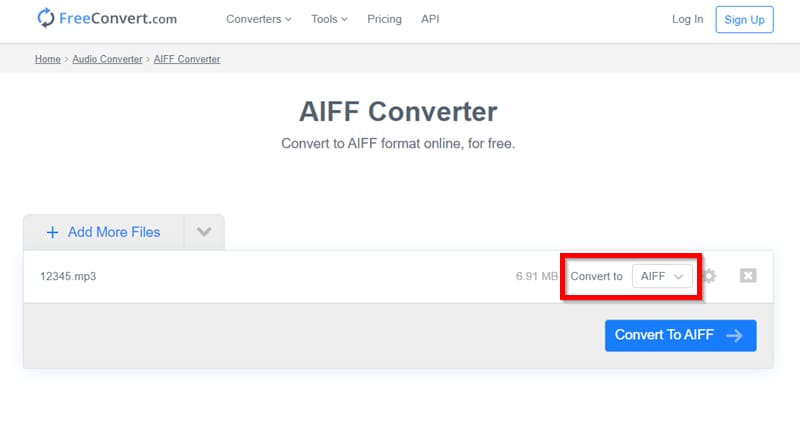
03Step 3: Play with Advanced Settings
This is optional, but if you want, you can adjust certain audio parameters by taking advantage of the ‘Advanced Settings’ option
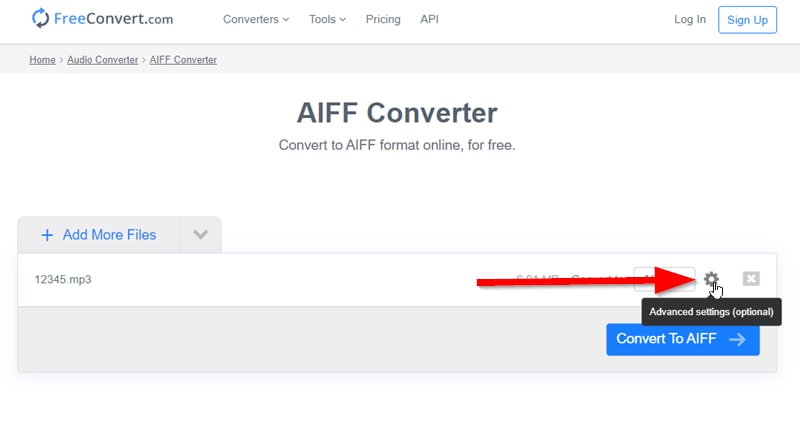
04Step 4: Convert M4A to AIFF
Now it’s time to finally convert In this case, that is as easy as selecting the ‘Convert to AIFF’ button.
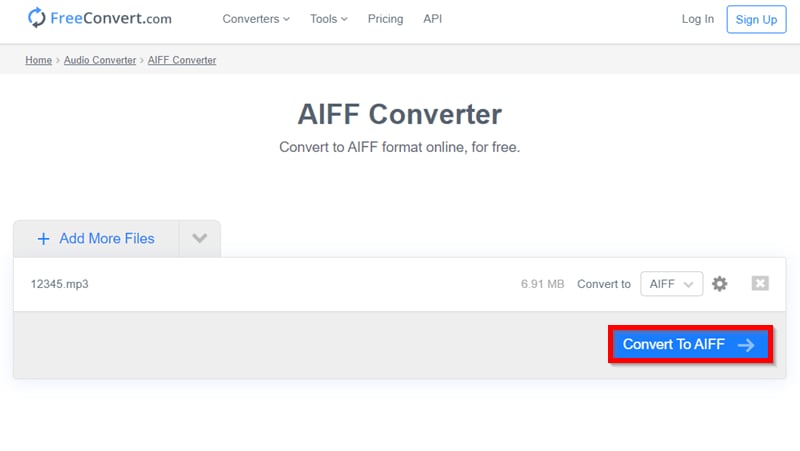
05Step 5: Download AIFF
When the conversion has been completed, click the ‘Download AIFF’ to finish up and save the converted AIFF file to your computer.

Part 3 What Makes AIFF Converter the Best Free Online Tool for Mac Users?
For this next part, we’ll be demonstrating an AIFF Converter that can be downloaded and used by Mac users. And then we’ll be following it up with a long list of all the best AIFF Converters available online and for both Windows and Mac users
01How to Use Free Audio AIFF Converter on Win/Mac?
As promised, this first part is a demonstration on how you can convert M4A to AIFF with a converter that will work for both Windows and Mac. This free audio converter is called ‘MediaHuman Audio Converter.’ It’s a really simple converter and is a great option for those who see themselves requiring an audio converter often but still don’t feel it necessary to cough up extra money for premium software when they can get a free one
**Step 1: Add File(s) for Conversion
First things first, upload the file that you want to convert With MediaHuman, you can do this in one of three ways:
● Drop media onto the specified area
● Click the “+” file option in order to manually add file
● Click the “+ folder” option in order to manually add files

**Step 2: Select Format
Once your file has been uploaded, select the “Format” button in the middle of the toolbar This will cause a pop-up to appear where you can choose your desired output format Of course, in our case, we chose “AIFF”

**Step 3: Start Conversion
Next, click ‘Start Conversion’ This will initiate the conversion. After which, you’ll be able to save your converted AIFF file and store it for use.

0210 Best AIFF Converter for Lossless Conversion
Now for our list of the best AIFF Converters available right now We’ve made sure to pick a good variety of them that you can choose from. Some of which are online tools, like we introduced in Part 1, while the others will be downloaded software that you can have at the ready at all times, like what we introduced in Part 2, Section 1
Keywords: aiff converter, m4a to aiff, convert m4a to aiff
**1. Zamzar
For the first AIFF Converter on this list, we have ZAMZAR ZAMZAR is an online file conversion tool that is capable of converting in a variety of file formats. Of course, the one that we’ll be looking at today is Zamzar’s AIFF Converter — which is almost 100% FREE to use (there’s a max upload file size that can only be unlocked if you pay the premium fee).
| Highlights | Highlights |
|---|---|
| ● FREEmium Online AIFF Converter● Wide variety of input and output file formats to choose from● No loss of quality and efficient conversion speed | ● Not 100% FREE, must pay to unlock certain functions● There is a max upload size for the FREE version (50MB)● Internet is required in order for use |

**2. ConvertOnMac
Our next recommended tool is Convert on Mac This is another online tool that can be used to convert a variety of files (i.e., audio, video, image, document, etc). The one that we’ll be focusing on though is Convert on Mac’s AIFF Converter
| Highlights | Highlights |
|---|---|
| ● Supports a variety of file input and output formats● Special AIFF Converter available for easy conversion● File upload can be done both manually or through a URL | ● Available online only● Most compatible for Mac users (as is evident from the name)● Not the best for bulk conversions |
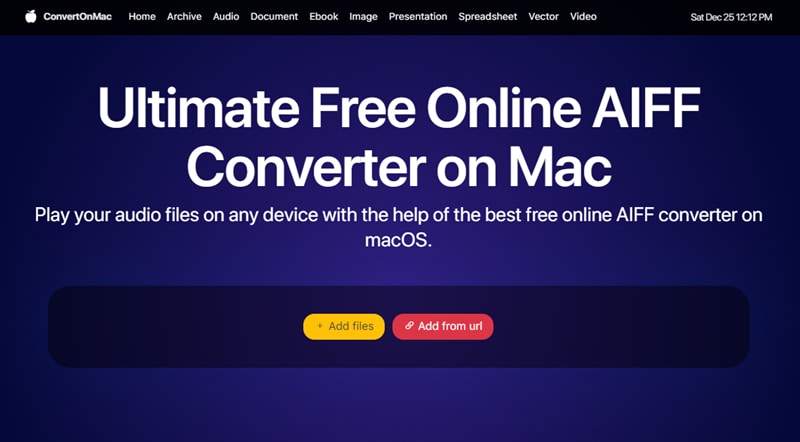
**3. Online Converter
The next one up is Online Converter This one is more like ZAMZAR than Convert on Mac. If only because it also comes with a max file size that is locked. It’s more limited though — in that it doesn’t support as many input and output formats. And, as you can no doubt guess from the interface, quite old-school as well.
| Highlights | Highlights |
|---|---|
| ● Specialized AIFF Converter● Functions as a converter for other file types as well● Large max file size | ● Available online only● Max upload file size is 200MB● Slower, less efficient conversion speed |

**4. Wondershare Filmora Video Editor
For this next AIFF Converter, we make a complete departure from your general converters by introducing a completely different beast altogether Specifically, in the form of a Video Editor called Filmora. Filmora is an incredibly advanced video editing tool. And, because of this, it’s capable of most things related to video and audio editing. Including, in this case, AIFF conversion
| Highlights | Highlights |
|---|---|
| ● Advanced video and audio functions for adjusting audio output parameters● Supports dozens of audio and video file formats● Produces high-quality end product | ● FREEmium product, certain functions are locked in the FREE version● Download and installation is required● Not the most beginner-friendly |
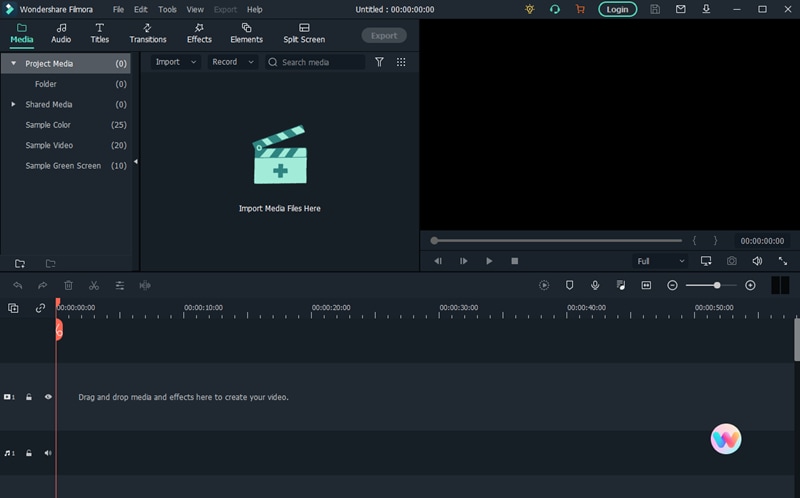
**5. EaseUS Video Converter
With ‘EaseUS Video Converter’ we continue on our trend of AIFF conversion software This one, despite its name suggesting otherwise, functions as a solid Audio Converter So far, it’s closest to Filmora Pro when compared to all the others on this list. It’s a one-trick kind of pony though. Seeing as, unlike with Filmora, you can really only use this to convert files.
| Highlights | Highlights |
|---|---|
| ● High-quality video and audio conversion● Supports dozens of input and output formats● FREE trial available | ● Limited FREE Trial● Supports Windows OS only● Download and installation is required for use |
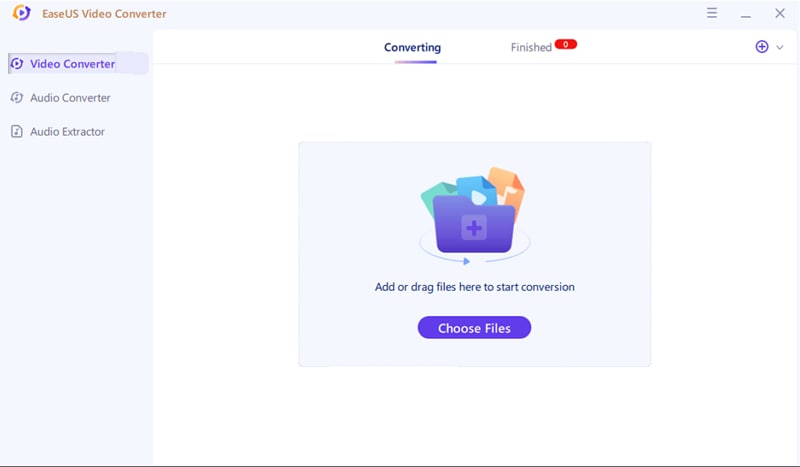
**6. Wondershare UniConverter
This next software, the ‘Wondershare UniConverter’ is a bit of a mix between Filmora and EaseUS Video Converter. As is evident from the UI (shown-off in the screenshot provided), it has the makings of a straightforward converter but with extra tools (i.e., video editor, video compressor, merger, screen recorder, etc.) that you can take advantage of while working on your conversions.
| Highlights | Highlights |
|---|---|
| ● Extra features for editing input and output files● Supports up to 1000 formats● High-speed Conversion rates | ● FREEmium program● Certain functions are locked in the FREE version of the program● Download and installation is required for use |
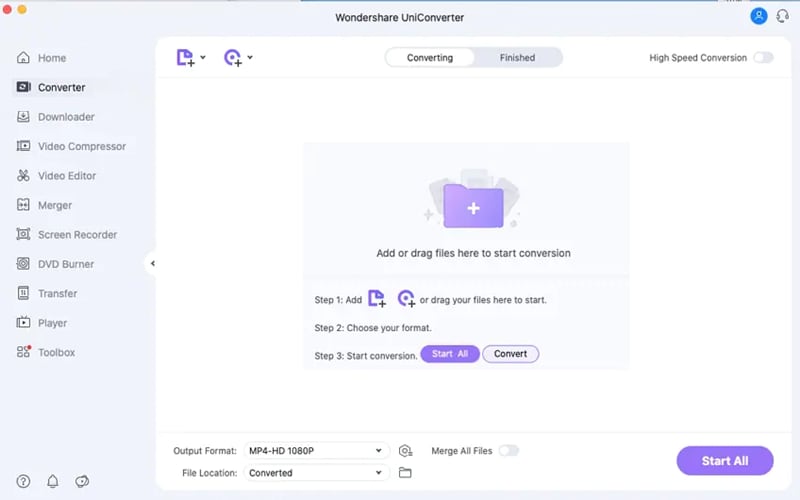
**7. VSDC Free Audio Converter
Next up, we have VSDC VSDC is a FREE Audio Converter. It’s pretty old-school (as is perhaps evident from the UI example) but it supports a variety of audio formats, including AIFF, which earned it a spot on this list of ours
| Highlights | Highlights |
|---|---|
| ● Supports all the key formats for both input and output● Built-in editor for trimming audio● High-conversion quality | ● Open-source, and thus not update as often● The conversion speed is slow● Old-school interface |

**8. Switch Audio File Converter
Switch Audio File Converter is a Mac AIFF Converter. You can find it on the Mac APP Store, or purchase it directly on the NCH Software website. For the FREE app version, you have access to certain functions, with the rest being locked under in-app purchases.
| Highlights | Highlights |
|---|---|
| ● Supports over 40+ audio file formats● Batch conversion functionalities available● Convert from video to audio easily | ● Convert from video to audio easily● Faulty AIFF to OGG conversion● Comes with lots of bugs |
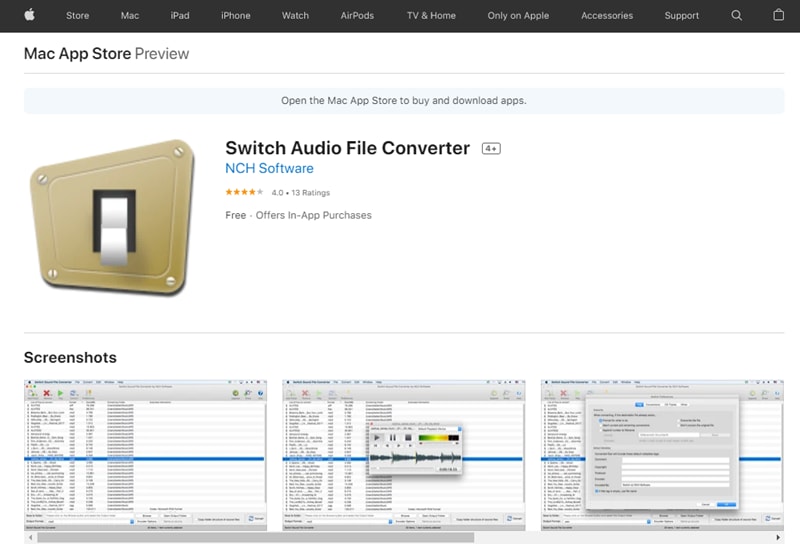
**9. iTunes - Apple
This is a hidden feature that not many people know about, but iTunes actually works as a pretty serviceable AIFF Converter. It’s not the most efficient, but with iTunes’ AIFF Encoder, conversion to AIFF is possible (converting from AIFF to MP3, and WAV is also possible because iTunes provides Encoders for those as well).
| Highlights | Highlights |
|---|---|
| ● FREE software, pre-installed on Mac computers● Quality settings to ensure good sound quality● AIFF-specific converter | ● No bulk-conversions available● Inefficient AIFF conversion● It will need to be downloaded and installed manually for Windows |

**10. Convertio
Last, but not least, is Convertio We circle back with this fourth and last online converter It’s actually quite advanced. Although, just like many of the other FREEmium online converters we’ve listed, it’s not 100% FREE and comes with a lot of limitations.
| Highlights | Highlights |
|---|---|
| ● Supports all the general audio files● Various ways to upload● High-quality conversions | ● FREEmium online converter● 100MB upload limit for the FREE version● Slow conversion |

Key Takeaways from This Episode
● The AIFF file format is notable because it results in higher-quality sound. This is because AIFF, unlike the more general, MP3 file format, is not a compressed format.
● There are various ways that you can convert from and to the AIFF file format. The first method that we introduced was an online tool that would be available for use no matter what computer or device you’re using The second was chosen specifically because it was FREE and available for both Windows and Mac
● If you’re interested in looking through other options, the ten other converters we introduced should provide a healthy lot for you to choose from — with various levels of usefulness depending on what you need an AIFF Converter.
“I need to convert some general audio files to AIFF, do you have any recommendations?”
We do, in fact, have some recommendations for you! The AIFF file format, while generally obscure, is accepted by most general audio converters! So, we didn’t have any problem finding some that you can use to AIFF converter!
In this article
01 [What’s So Good About AIFF?](#Part 1)
02 [How to Convert M4A to AIFF Free and Easily](#Part 2)
03 [What Makes AIFF Converter the Best Free Online Tool for Mac Users?](#Part 3)
Part 1 What’s So Good About AIFF?
But okay, what’s the deal with AIFF? Is it really all that good? And, if it is, why? For the first part of this article, we’ve prepared a short overview on the AIFF file format You can skip ahead though if you’d prefer to see the tutorial on AIFF Converters or our list of recommendations.
01What’s AIFF?
AIFF, also called the Audio Interchange File Format, is an audio file format that was popularized in 1988. It was based on the Electronic Arts Interchange File Format and is probably most familiar for Mac users. It’s accepted by most media players, including Apple Music and the Apple QuickTime Player.
02Why Is It So Popular?
Why? Well, it all has to do with the loss of quality. AIFF files are notable because they are uncompressed — leading to an inarguably better sound. That makes it popular with content creators, who want to provide the best possible listening experience to their audience. The caveat to this, of course, is that its uncompressed state means that it takes up a lot more space on one’s disk drive. But, many people would be willing to give that up in exchange for the enhanced sound.
Part 2 How to Convert M4A to AIFF Free and Easily
For this next section, we’ll be teaching you how to convert M4A to AIFF with an online AIFF converter. The benefit of using an online converter like the one we’ll be showing you how to use is that it is usually FREE and very efficient. This makes it a perfect solution for those who are just looking to convert to or from AIFF occasionally and thus has no need for a more permanent solution.
01Step 1: Launch Online AIFF Converter & Upload Files
The first thing that you have to do is open up the online AIFF Converter that you want to use. For our example, we’ve chosen FreeConvert, but there are plenty of other ones out there for you to choose from
Once you’re on-site, make use of the upload options to prepare your file to be converted. In this case, we uploaded an MP3 file, but it will work for M4A to AIFF just as well (along with other file formats.)

02Step 2: Convert to ‘AIFF’
Once the file that you want to convert has finished uploading, confirm that the output file format has been set to “AIFF”.

03Step 3: Play with Advanced Settings
This is optional, but if you want, you can adjust certain audio parameters by taking advantage of the ‘Advanced Settings’ option

04Step 4: Convert M4A to AIFF
Now it’s time to finally convert In this case, that is as easy as selecting the ‘Convert to AIFF’ button.

05Step 5: Download AIFF
When the conversion has been completed, click the ‘Download AIFF’ to finish up and save the converted AIFF file to your computer.

Part 3 What Makes AIFF Converter the Best Free Online Tool for Mac Users?
For this next part, we’ll be demonstrating an AIFF Converter that can be downloaded and used by Mac users. And then we’ll be following it up with a long list of all the best AIFF Converters available online and for both Windows and Mac users
01How to Use Free Audio AIFF Converter on Win/Mac?
As promised, this first part is a demonstration on how you can convert M4A to AIFF with a converter that will work for both Windows and Mac. This free audio converter is called ‘MediaHuman Audio Converter.’ It’s a really simple converter and is a great option for those who see themselves requiring an audio converter often but still don’t feel it necessary to cough up extra money for premium software when they can get a free one
**Step 1: Add File(s) for Conversion
First things first, upload the file that you want to convert With MediaHuman, you can do this in one of three ways:
● Drop media onto the specified area
● Click the “+” file option in order to manually add file
● Click the “+ folder” option in order to manually add files

**Step 2: Select Format
Once your file has been uploaded, select the “Format” button in the middle of the toolbar This will cause a pop-up to appear where you can choose your desired output format Of course, in our case, we chose “AIFF”

**Step 3: Start Conversion
Next, click ‘Start Conversion’ This will initiate the conversion. After which, you’ll be able to save your converted AIFF file and store it for use.

0210 Best AIFF Converter for Lossless Conversion
Now for our list of the best AIFF Converters available right now We’ve made sure to pick a good variety of them that you can choose from. Some of which are online tools, like we introduced in Part 1, while the others will be downloaded software that you can have at the ready at all times, like what we introduced in Part 2, Section 1
Keywords: aiff converter, m4a to aiff, convert m4a to aiff
**1. Zamzar
For the first AIFF Converter on this list, we have ZAMZAR ZAMZAR is an online file conversion tool that is capable of converting in a variety of file formats. Of course, the one that we’ll be looking at today is Zamzar’s AIFF Converter — which is almost 100% FREE to use (there’s a max upload file size that can only be unlocked if you pay the premium fee).
| Highlights | Highlights |
|---|---|
| ● FREEmium Online AIFF Converter● Wide variety of input and output file formats to choose from● No loss of quality and efficient conversion speed | ● Not 100% FREE, must pay to unlock certain functions● There is a max upload size for the FREE version (50MB)● Internet is required in order for use |

**2. ConvertOnMac
Our next recommended tool is Convert on Mac This is another online tool that can be used to convert a variety of files (i.e., audio, video, image, document, etc). The one that we’ll be focusing on though is Convert on Mac’s AIFF Converter
| Highlights | Highlights |
|---|---|
| ● Supports a variety of file input and output formats● Special AIFF Converter available for easy conversion● File upload can be done both manually or through a URL | ● Available online only● Most compatible for Mac users (as is evident from the name)● Not the best for bulk conversions |

**3. Online Converter
The next one up is Online Converter This one is more like ZAMZAR than Convert on Mac. If only because it also comes with a max file size that is locked. It’s more limited though — in that it doesn’t support as many input and output formats. And, as you can no doubt guess from the interface, quite old-school as well.
| Highlights | Highlights |
|---|---|
| ● Specialized AIFF Converter● Functions as a converter for other file types as well● Large max file size | ● Available online only● Max upload file size is 200MB● Slower, less efficient conversion speed |

**4. Wondershare Filmora Video Editor
For this next AIFF Converter, we make a complete departure from your general converters by introducing a completely different beast altogether Specifically, in the form of a Video Editor called Filmora. Filmora is an incredibly advanced video editing tool. And, because of this, it’s capable of most things related to video and audio editing. Including, in this case, AIFF conversion
| Highlights | Highlights |
|---|---|
| ● Advanced video and audio functions for adjusting audio output parameters● Supports dozens of audio and video file formats● Produces high-quality end product | ● FREEmium product, certain functions are locked in the FREE version● Download and installation is required● Not the most beginner-friendly |

**5. EaseUS Video Converter
With ‘EaseUS Video Converter’ we continue on our trend of AIFF conversion software This one, despite its name suggesting otherwise, functions as a solid Audio Converter So far, it’s closest to Filmora Pro when compared to all the others on this list. It’s a one-trick kind of pony though. Seeing as, unlike with Filmora, you can really only use this to convert files.
| Highlights | Highlights |
|---|---|
| ● High-quality video and audio conversion● Supports dozens of input and output formats● FREE trial available | ● Limited FREE Trial● Supports Windows OS only● Download and installation is required for use |

**6. Wondershare UniConverter
This next software, the ‘Wondershare UniConverter’ is a bit of a mix between Filmora and EaseUS Video Converter. As is evident from the UI (shown-off in the screenshot provided), it has the makings of a straightforward converter but with extra tools (i.e., video editor, video compressor, merger, screen recorder, etc.) that you can take advantage of while working on your conversions.
| Highlights | Highlights |
|---|---|
| ● Extra features for editing input and output files● Supports up to 1000 formats● High-speed Conversion rates | ● FREEmium program● Certain functions are locked in the FREE version of the program● Download and installation is required for use |

**7. VSDC Free Audio Converter
Next up, we have VSDC VSDC is a FREE Audio Converter. It’s pretty old-school (as is perhaps evident from the UI example) but it supports a variety of audio formats, including AIFF, which earned it a spot on this list of ours
| Highlights | Highlights |
|---|---|
| ● Supports all the key formats for both input and output● Built-in editor for trimming audio● High-conversion quality | ● Open-source, and thus not update as often● The conversion speed is slow● Old-school interface |

**8. Switch Audio File Converter
Switch Audio File Converter is a Mac AIFF Converter. You can find it on the Mac APP Store, or purchase it directly on the NCH Software website. For the FREE app version, you have access to certain functions, with the rest being locked under in-app purchases.
| Highlights | Highlights |
|---|---|
| ● Supports over 40+ audio file formats● Batch conversion functionalities available● Convert from video to audio easily | ● Convert from video to audio easily● Faulty AIFF to OGG conversion● Comes with lots of bugs |

**9. iTunes - Apple
This is a hidden feature that not many people know about, but iTunes actually works as a pretty serviceable AIFF Converter. It’s not the most efficient, but with iTunes’ AIFF Encoder, conversion to AIFF is possible (converting from AIFF to MP3, and WAV is also possible because iTunes provides Encoders for those as well).
| Highlights | Highlights |
|---|---|
| ● FREE software, pre-installed on Mac computers● Quality settings to ensure good sound quality● AIFF-specific converter | ● No bulk-conversions available● Inefficient AIFF conversion● It will need to be downloaded and installed manually for Windows |

**10. Convertio
Last, but not least, is Convertio We circle back with this fourth and last online converter It’s actually quite advanced. Although, just like many of the other FREEmium online converters we’ve listed, it’s not 100% FREE and comes with a lot of limitations.
| Highlights | Highlights |
|---|---|
| ● Supports all the general audio files● Various ways to upload● High-quality conversions | ● FREEmium online converter● 100MB upload limit for the FREE version● Slow conversion |

Key Takeaways from This Episode
● The AIFF file format is notable because it results in higher-quality sound. This is because AIFF, unlike the more general, MP3 file format, is not a compressed format.
● There are various ways that you can convert from and to the AIFF file format. The first method that we introduced was an online tool that would be available for use no matter what computer or device you’re using The second was chosen specifically because it was FREE and available for both Windows and Mac
● If you’re interested in looking through other options, the ten other converters we introduced should provide a healthy lot for you to choose from — with various levels of usefulness depending on what you need an AIFF Converter.
“I need to convert some general audio files to AIFF, do you have any recommendations?”
We do, in fact, have some recommendations for you! The AIFF file format, while generally obscure, is accepted by most general audio converters! So, we didn’t have any problem finding some that you can use to AIFF converter!
In this article
01 [What’s So Good About AIFF?](#Part 1)
02 [How to Convert M4A to AIFF Free and Easily](#Part 2)
03 [What Makes AIFF Converter the Best Free Online Tool for Mac Users?](#Part 3)
Part 1 What’s So Good About AIFF?
But okay, what’s the deal with AIFF? Is it really all that good? And, if it is, why? For the first part of this article, we’ve prepared a short overview on the AIFF file format You can skip ahead though if you’d prefer to see the tutorial on AIFF Converters or our list of recommendations.
01What’s AIFF?
AIFF, also called the Audio Interchange File Format, is an audio file format that was popularized in 1988. It was based on the Electronic Arts Interchange File Format and is probably most familiar for Mac users. It’s accepted by most media players, including Apple Music and the Apple QuickTime Player.
02Why Is It So Popular?
Why? Well, it all has to do with the loss of quality. AIFF files are notable because they are uncompressed — leading to an inarguably better sound. That makes it popular with content creators, who want to provide the best possible listening experience to their audience. The caveat to this, of course, is that its uncompressed state means that it takes up a lot more space on one’s disk drive. But, many people would be willing to give that up in exchange for the enhanced sound.
Part 2 How to Convert M4A to AIFF Free and Easily
For this next section, we’ll be teaching you how to convert M4A to AIFF with an online AIFF converter. The benefit of using an online converter like the one we’ll be showing you how to use is that it is usually FREE and very efficient. This makes it a perfect solution for those who are just looking to convert to or from AIFF occasionally and thus has no need for a more permanent solution.
01Step 1: Launch Online AIFF Converter & Upload Files
The first thing that you have to do is open up the online AIFF Converter that you want to use. For our example, we’ve chosen FreeConvert, but there are plenty of other ones out there for you to choose from
Once you’re on-site, make use of the upload options to prepare your file to be converted. In this case, we uploaded an MP3 file, but it will work for M4A to AIFF just as well (along with other file formats.)

02Step 2: Convert to ‘AIFF’
Once the file that you want to convert has finished uploading, confirm that the output file format has been set to “AIFF”.

03Step 3: Play with Advanced Settings
This is optional, but if you want, you can adjust certain audio parameters by taking advantage of the ‘Advanced Settings’ option

04Step 4: Convert M4A to AIFF
Now it’s time to finally convert In this case, that is as easy as selecting the ‘Convert to AIFF’ button.

05Step 5: Download AIFF
When the conversion has been completed, click the ‘Download AIFF’ to finish up and save the converted AIFF file to your computer.

Part 3 What Makes AIFF Converter the Best Free Online Tool for Mac Users?
For this next part, we’ll be demonstrating an AIFF Converter that can be downloaded and used by Mac users. And then we’ll be following it up with a long list of all the best AIFF Converters available online and for both Windows and Mac users
01How to Use Free Audio AIFF Converter on Win/Mac?
As promised, this first part is a demonstration on how you can convert M4A to AIFF with a converter that will work for both Windows and Mac. This free audio converter is called ‘MediaHuman Audio Converter.’ It’s a really simple converter and is a great option for those who see themselves requiring an audio converter often but still don’t feel it necessary to cough up extra money for premium software when they can get a free one
**Step 1: Add File(s) for Conversion
First things first, upload the file that you want to convert With MediaHuman, you can do this in one of three ways:
● Drop media onto the specified area
● Click the “+” file option in order to manually add file
● Click the “+ folder” option in order to manually add files

**Step 2: Select Format
Once your file has been uploaded, select the “Format” button in the middle of the toolbar This will cause a pop-up to appear where you can choose your desired output format Of course, in our case, we chose “AIFF”

**Step 3: Start Conversion
Next, click ‘Start Conversion’ This will initiate the conversion. After which, you’ll be able to save your converted AIFF file and store it for use.

0210 Best AIFF Converter for Lossless Conversion
Now for our list of the best AIFF Converters available right now We’ve made sure to pick a good variety of them that you can choose from. Some of which are online tools, like we introduced in Part 1, while the others will be downloaded software that you can have at the ready at all times, like what we introduced in Part 2, Section 1
Keywords: aiff converter, m4a to aiff, convert m4a to aiff
**1. Zamzar
For the first AIFF Converter on this list, we have ZAMZAR ZAMZAR is an online file conversion tool that is capable of converting in a variety of file formats. Of course, the one that we’ll be looking at today is Zamzar’s AIFF Converter — which is almost 100% FREE to use (there’s a max upload file size that can only be unlocked if you pay the premium fee).
| Highlights | Highlights |
|---|---|
| ● FREEmium Online AIFF Converter● Wide variety of input and output file formats to choose from● No loss of quality and efficient conversion speed | ● Not 100% FREE, must pay to unlock certain functions● There is a max upload size for the FREE version (50MB)● Internet is required in order for use |

**2. ConvertOnMac
Our next recommended tool is Convert on Mac This is another online tool that can be used to convert a variety of files (i.e., audio, video, image, document, etc). The one that we’ll be focusing on though is Convert on Mac’s AIFF Converter
| Highlights | Highlights |
|---|---|
| ● Supports a variety of file input and output formats● Special AIFF Converter available for easy conversion● File upload can be done both manually or through a URL | ● Available online only● Most compatible for Mac users (as is evident from the name)● Not the best for bulk conversions |

**3. Online Converter
The next one up is Online Converter This one is more like ZAMZAR than Convert on Mac. If only because it also comes with a max file size that is locked. It’s more limited though — in that it doesn’t support as many input and output formats. And, as you can no doubt guess from the interface, quite old-school as well.
| Highlights | Highlights |
|---|---|
| ● Specialized AIFF Converter● Functions as a converter for other file types as well● Large max file size | ● Available online only● Max upload file size is 200MB● Slower, less efficient conversion speed |

**4. Wondershare Filmora Video Editor
For this next AIFF Converter, we make a complete departure from your general converters by introducing a completely different beast altogether Specifically, in the form of a Video Editor called Filmora. Filmora is an incredibly advanced video editing tool. And, because of this, it’s capable of most things related to video and audio editing. Including, in this case, AIFF conversion
| Highlights | Highlights |
|---|---|
| ● Advanced video and audio functions for adjusting audio output parameters● Supports dozens of audio and video file formats● Produces high-quality end product | ● FREEmium product, certain functions are locked in the FREE version● Download and installation is required● Not the most beginner-friendly |

**5. EaseUS Video Converter
With ‘EaseUS Video Converter’ we continue on our trend of AIFF conversion software This one, despite its name suggesting otherwise, functions as a solid Audio Converter So far, it’s closest to Filmora Pro when compared to all the others on this list. It’s a one-trick kind of pony though. Seeing as, unlike with Filmora, you can really only use this to convert files.
| Highlights | Highlights |
|---|---|
| ● High-quality video and audio conversion● Supports dozens of input and output formats● FREE trial available | ● Limited FREE Trial● Supports Windows OS only● Download and installation is required for use |

**6. Wondershare UniConverter
This next software, the ‘Wondershare UniConverter’ is a bit of a mix between Filmora and EaseUS Video Converter. As is evident from the UI (shown-off in the screenshot provided), it has the makings of a straightforward converter but with extra tools (i.e., video editor, video compressor, merger, screen recorder, etc.) that you can take advantage of while working on your conversions.
| Highlights | Highlights |
|---|---|
| ● Extra features for editing input and output files● Supports up to 1000 formats● High-speed Conversion rates | ● FREEmium program● Certain functions are locked in the FREE version of the program● Download and installation is required for use |

**7. VSDC Free Audio Converter
Next up, we have VSDC VSDC is a FREE Audio Converter. It’s pretty old-school (as is perhaps evident from the UI example) but it supports a variety of audio formats, including AIFF, which earned it a spot on this list of ours
| Highlights | Highlights |
|---|---|
| ● Supports all the key formats for both input and output● Built-in editor for trimming audio● High-conversion quality | ● Open-source, and thus not update as often● The conversion speed is slow● Old-school interface |

**8. Switch Audio File Converter
Switch Audio File Converter is a Mac AIFF Converter. You can find it on the Mac APP Store, or purchase it directly on the NCH Software website. For the FREE app version, you have access to certain functions, with the rest being locked under in-app purchases.
| Highlights | Highlights |
|---|---|
| ● Supports over 40+ audio file formats● Batch conversion functionalities available● Convert from video to audio easily | ● Convert from video to audio easily● Faulty AIFF to OGG conversion● Comes with lots of bugs |

**9. iTunes - Apple
This is a hidden feature that not many people know about, but iTunes actually works as a pretty serviceable AIFF Converter. It’s not the most efficient, but with iTunes’ AIFF Encoder, conversion to AIFF is possible (converting from AIFF to MP3, and WAV is also possible because iTunes provides Encoders for those as well).
| Highlights | Highlights |
|---|---|
| ● FREE software, pre-installed on Mac computers● Quality settings to ensure good sound quality● AIFF-specific converter | ● No bulk-conversions available● Inefficient AIFF conversion● It will need to be downloaded and installed manually for Windows |

**10. Convertio
Last, but not least, is Convertio We circle back with this fourth and last online converter It’s actually quite advanced. Although, just like many of the other FREEmium online converters we’ve listed, it’s not 100% FREE and comes with a lot of limitations.
| Highlights | Highlights |
|---|---|
| ● Supports all the general audio files● Various ways to upload● High-quality conversions | ● FREEmium online converter● 100MB upload limit for the FREE version● Slow conversion |

Key Takeaways from This Episode
● The AIFF file format is notable because it results in higher-quality sound. This is because AIFF, unlike the more general, MP3 file format, is not a compressed format.
● There are various ways that you can convert from and to the AIFF file format. The first method that we introduced was an online tool that would be available for use no matter what computer or device you’re using The second was chosen specifically because it was FREE and available for both Windows and Mac
● If you’re interested in looking through other options, the ten other converters we introduced should provide a healthy lot for you to choose from — with various levels of usefulness depending on what you need an AIFF Converter.
“I need to convert some general audio files to AIFF, do you have any recommendations?”
We do, in fact, have some recommendations for you! The AIFF file format, while generally obscure, is accepted by most general audio converters! So, we didn’t have any problem finding some that you can use to AIFF converter!
In this article
01 [What’s So Good About AIFF?](#Part 1)
02 [How to Convert M4A to AIFF Free and Easily](#Part 2)
03 [What Makes AIFF Converter the Best Free Online Tool for Mac Users?](#Part 3)
Part 1 What’s So Good About AIFF?
But okay, what’s the deal with AIFF? Is it really all that good? And, if it is, why? For the first part of this article, we’ve prepared a short overview on the AIFF file format You can skip ahead though if you’d prefer to see the tutorial on AIFF Converters or our list of recommendations.
01What’s AIFF?
AIFF, also called the Audio Interchange File Format, is an audio file format that was popularized in 1988. It was based on the Electronic Arts Interchange File Format and is probably most familiar for Mac users. It’s accepted by most media players, including Apple Music and the Apple QuickTime Player.
02Why Is It So Popular?
Why? Well, it all has to do with the loss of quality. AIFF files are notable because they are uncompressed — leading to an inarguably better sound. That makes it popular with content creators, who want to provide the best possible listening experience to their audience. The caveat to this, of course, is that its uncompressed state means that it takes up a lot more space on one’s disk drive. But, many people would be willing to give that up in exchange for the enhanced sound.
Part 2 How to Convert M4A to AIFF Free and Easily
For this next section, we’ll be teaching you how to convert M4A to AIFF with an online AIFF converter. The benefit of using an online converter like the one we’ll be showing you how to use is that it is usually FREE and very efficient. This makes it a perfect solution for those who are just looking to convert to or from AIFF occasionally and thus has no need for a more permanent solution.
01Step 1: Launch Online AIFF Converter & Upload Files
The first thing that you have to do is open up the online AIFF Converter that you want to use. For our example, we’ve chosen FreeConvert, but there are plenty of other ones out there for you to choose from
Once you’re on-site, make use of the upload options to prepare your file to be converted. In this case, we uploaded an MP3 file, but it will work for M4A to AIFF just as well (along with other file formats.)

02Step 2: Convert to ‘AIFF’
Once the file that you want to convert has finished uploading, confirm that the output file format has been set to “AIFF”.

03Step 3: Play with Advanced Settings
This is optional, but if you want, you can adjust certain audio parameters by taking advantage of the ‘Advanced Settings’ option

04Step 4: Convert M4A to AIFF
Now it’s time to finally convert In this case, that is as easy as selecting the ‘Convert to AIFF’ button.

05Step 5: Download AIFF
When the conversion has been completed, click the ‘Download AIFF’ to finish up and save the converted AIFF file to your computer.

Part 3 What Makes AIFF Converter the Best Free Online Tool for Mac Users?
For this next part, we’ll be demonstrating an AIFF Converter that can be downloaded and used by Mac users. And then we’ll be following it up with a long list of all the best AIFF Converters available online and for both Windows and Mac users
01How to Use Free Audio AIFF Converter on Win/Mac?
As promised, this first part is a demonstration on how you can convert M4A to AIFF with a converter that will work for both Windows and Mac. This free audio converter is called ‘MediaHuman Audio Converter.’ It’s a really simple converter and is a great option for those who see themselves requiring an audio converter often but still don’t feel it necessary to cough up extra money for premium software when they can get a free one
**Step 1: Add File(s) for Conversion
First things first, upload the file that you want to convert With MediaHuman, you can do this in one of three ways:
● Drop media onto the specified area
● Click the “+” file option in order to manually add file
● Click the “+ folder” option in order to manually add files

**Step 2: Select Format
Once your file has been uploaded, select the “Format” button in the middle of the toolbar This will cause a pop-up to appear where you can choose your desired output format Of course, in our case, we chose “AIFF”

**Step 3: Start Conversion
Next, click ‘Start Conversion’ This will initiate the conversion. After which, you’ll be able to save your converted AIFF file and store it for use.

0210 Best AIFF Converter for Lossless Conversion
Now for our list of the best AIFF Converters available right now We’ve made sure to pick a good variety of them that you can choose from. Some of which are online tools, like we introduced in Part 1, while the others will be downloaded software that you can have at the ready at all times, like what we introduced in Part 2, Section 1
Keywords: aiff converter, m4a to aiff, convert m4a to aiff
**1. Zamzar
For the first AIFF Converter on this list, we have ZAMZAR ZAMZAR is an online file conversion tool that is capable of converting in a variety of file formats. Of course, the one that we’ll be looking at today is Zamzar’s AIFF Converter — which is almost 100% FREE to use (there’s a max upload file size that can only be unlocked if you pay the premium fee).
| Highlights | Highlights |
|---|---|
| ● FREEmium Online AIFF Converter● Wide variety of input and output file formats to choose from● No loss of quality and efficient conversion speed | ● Not 100% FREE, must pay to unlock certain functions● There is a max upload size for the FREE version (50MB)● Internet is required in order for use |

**2. ConvertOnMac
Our next recommended tool is Convert on Mac This is another online tool that can be used to convert a variety of files (i.e., audio, video, image, document, etc). The one that we’ll be focusing on though is Convert on Mac’s AIFF Converter
| Highlights | Highlights |
|---|---|
| ● Supports a variety of file input and output formats● Special AIFF Converter available for easy conversion● File upload can be done both manually or through a URL | ● Available online only● Most compatible for Mac users (as is evident from the name)● Not the best for bulk conversions |

**3. Online Converter
The next one up is Online Converter This one is more like ZAMZAR than Convert on Mac. If only because it also comes with a max file size that is locked. It’s more limited though — in that it doesn’t support as many input and output formats. And, as you can no doubt guess from the interface, quite old-school as well.
| Highlights | Highlights |
|---|---|
| ● Specialized AIFF Converter● Functions as a converter for other file types as well● Large max file size | ● Available online only● Max upload file size is 200MB● Slower, less efficient conversion speed |

**4. Wondershare Filmora Video Editor
For this next AIFF Converter, we make a complete departure from your general converters by introducing a completely different beast altogether Specifically, in the form of a Video Editor called Filmora. Filmora is an incredibly advanced video editing tool. And, because of this, it’s capable of most things related to video and audio editing. Including, in this case, AIFF conversion
| Highlights | Highlights |
|---|---|
| ● Advanced video and audio functions for adjusting audio output parameters● Supports dozens of audio and video file formats● Produces high-quality end product | ● FREEmium product, certain functions are locked in the FREE version● Download and installation is required● Not the most beginner-friendly |

**5. EaseUS Video Converter
With ‘EaseUS Video Converter’ we continue on our trend of AIFF conversion software This one, despite its name suggesting otherwise, functions as a solid Audio Converter So far, it’s closest to Filmora Pro when compared to all the others on this list. It’s a one-trick kind of pony though. Seeing as, unlike with Filmora, you can really only use this to convert files.
| Highlights | Highlights |
|---|---|
| ● High-quality video and audio conversion● Supports dozens of input and output formats● FREE trial available | ● Limited FREE Trial● Supports Windows OS only● Download and installation is required for use |

**6. Wondershare UniConverter
This next software, the ‘Wondershare UniConverter’ is a bit of a mix between Filmora and EaseUS Video Converter. As is evident from the UI (shown-off in the screenshot provided), it has the makings of a straightforward converter but with extra tools (i.e., video editor, video compressor, merger, screen recorder, etc.) that you can take advantage of while working on your conversions.
| Highlights | Highlights |
|---|---|
| ● Extra features for editing input and output files● Supports up to 1000 formats● High-speed Conversion rates | ● FREEmium program● Certain functions are locked in the FREE version of the program● Download and installation is required for use |

**7. VSDC Free Audio Converter
Next up, we have VSDC VSDC is a FREE Audio Converter. It’s pretty old-school (as is perhaps evident from the UI example) but it supports a variety of audio formats, including AIFF, which earned it a spot on this list of ours
| Highlights | Highlights |
|---|---|
| ● Supports all the key formats for both input and output● Built-in editor for trimming audio● High-conversion quality | ● Open-source, and thus not update as often● The conversion speed is slow● Old-school interface |

**8. Switch Audio File Converter
Switch Audio File Converter is a Mac AIFF Converter. You can find it on the Mac APP Store, or purchase it directly on the NCH Software website. For the FREE app version, you have access to certain functions, with the rest being locked under in-app purchases.
| Highlights | Highlights |
|---|---|
| ● Supports over 40+ audio file formats● Batch conversion functionalities available● Convert from video to audio easily | ● Convert from video to audio easily● Faulty AIFF to OGG conversion● Comes with lots of bugs |

**9. iTunes - Apple
This is a hidden feature that not many people know about, but iTunes actually works as a pretty serviceable AIFF Converter. It’s not the most efficient, but with iTunes’ AIFF Encoder, conversion to AIFF is possible (converting from AIFF to MP3, and WAV is also possible because iTunes provides Encoders for those as well).
| Highlights | Highlights |
|---|---|
| ● FREE software, pre-installed on Mac computers● Quality settings to ensure good sound quality● AIFF-specific converter | ● No bulk-conversions available● Inefficient AIFF conversion● It will need to be downloaded and installed manually for Windows |

**10. Convertio
Last, but not least, is Convertio We circle back with this fourth and last online converter It’s actually quite advanced. Although, just like many of the other FREEmium online converters we’ve listed, it’s not 100% FREE and comes with a lot of limitations.
| Highlights | Highlights |
|---|---|
| ● Supports all the general audio files● Various ways to upload● High-quality conversions | ● FREEmium online converter● 100MB upload limit for the FREE version● Slow conversion |

Key Takeaways from This Episode
● The AIFF file format is notable because it results in higher-quality sound. This is because AIFF, unlike the more general, MP3 file format, is not a compressed format.
● There are various ways that you can convert from and to the AIFF file format. The first method that we introduced was an online tool that would be available for use no matter what computer or device you’re using The second was chosen specifically because it was FREE and available for both Windows and Mac
● If you’re interested in looking through other options, the ten other converters we introduced should provide a healthy lot for you to choose from — with various levels of usefulness depending on what you need an AIFF Converter.
Also read:
- New In 2024, Windows Live Movie Maker Tutorial Adding Slow Motion to Your Videos
- Free Online Video Combiner Tools Top Picks for 2024
- In 2024, Free MOV Video Editor Roundup Top 10 Options
- Updated In 2024, Video Editing Face-Off Final Cut Pro vs LumaFusion - Which One Wins?
- New Bring Your Ideas to Life Top Free 3D Animation Apps for Android and iPhone for 2024
- New 10 Essential Video Editing Programs for Professionals for 2024
- In 2024, Your Go-To Guide 10 Best Public Domain Image Resources
- Updated 2024 Approved Converting MP4 Video File to an MP3 File Format Is a Simple Process. Read on if You Would Like to Learn More About the Best MP4 to MP3 Converters You Can Use Online or on PC and Mac Computers
- Quik, But Not Quick Enough? A Review & PC Alternatives for Faster Video Editing
- New Effortless FLV Editing on Windows 8 The Ultimate Guide for 2024
- Updated Optimize Your LinkedIn Videos The Best Aspect Ratios for Maximum Engagement
- New In 2024, S Best Free WMV Video Editing Software for Splitting
- New 2024 Approved Unleash Creativity Top Free Video Effects Apps for iPhone and Android
- Updated No-Shake Guarantee Best Free Video Stabilizers
- Updated Best Mobile Animation Tools Free 3D Apps for Android and iOS
- New 2024 Approved Free Sound Effects for Final Cut Pro A Step-by-Step Guide
- Updated Best Free AVI Video Rotators Multi-Platform Solutions Compared for 2024
- New Top 10 Budget-Friendly Filmmaking Tools for Indie Creators for 2024
- New Elevate Your Storytelling GoPro Quik Video Editing Essentials for MacBook for 2024
- New 2024 Approved Top Chromebook Video Editing Software Free Options
- 2024 Approved FREE Best Video Special Effects Apps
- New From WebM to MP4 The Top 10 Conversion Tools You Need for 2024
- Updated 2024 Approved Ranking the Top Web-Based Vertical Video Editors
- In 2024, Top 11 Free Apps to Check IMEI on Nokia C02 Phones
- Solved Warning Camera Failed on Honor Magic 5 | Dr.fone
- Does Life360 Notify When You Log Out On Honor Magic 5 Pro? | Dr.fone
- How to Reset a Locked Realme 11X 5G Phone
- In 2024, This Blog Post Will Walk You Through How to Resize Videos Using VLC. Well Cover What the Default Settings Are for Video Resolutions, How to Change Them, and Why Its Important to Know What Size of Video Youre Uploading Before Uploading It
- How to Successfully Bypass iCloud Activation Lock on iPhone 7 Plus
- In 2024, 2 Ways to Monitor Xiaomi Redmi 12 5G Activity | Dr.fone
- Fake Android Location without Rooting For Your Nokia G42 5G | Dr.fone
- 6 Fixes to Unfortunately WhatsApp has stopped Error Popups On Vivo S17 | Dr.fone
- In 2024, Resolve Your iPhone XS Keeps Asking for Outlook Password
- MP4 won't play on my Galaxy F54 5G
- How to Resolve Nokia C02 Screen Not Working | Dr.fone
- How To Remove iCloud On Apple iPhone 15 Smoothly
- In 2024, How to Intercept Text Messages on Sony Xperia 1 V | Dr.fone
- What are Location Permissions Life360 On Tecno Pova 5? | Dr.fone
- New Wondershare Filmora Has Introduced a New Feature - AI Portrait Effect that You Can Use to Remove Background From Various Videos and Images. Explore the Uses, Benefits, and Real-Life Scenarios of This Feature in a Comprehensive Guide
- Title: Elevate Your Storytelling Adding Picture-in-Picture Elements to Your FCP Projects for 2024
- Author: Amelia
- Created at : 2024-05-19 11:47:22
- Updated at : 2024-05-20 11:47:22
- Link: https://ai-driven-video-production.techidaily.com/elevate-your-storytelling-adding-picture-in-picture-elements-to-your-fcp-projects-for-2024/
- License: This work is licensed under CC BY-NC-SA 4.0.

